Exploring our foods, our stories, our community by season.

TASTING SPOT
Growing and using herbs

Exploring our foods, our stories, our community by season.

TASTING SPOT
Growing and using herbs
An old Creston haunt
A Member of Edible Communities
PERSPECTIVE
Food critic chews the fat
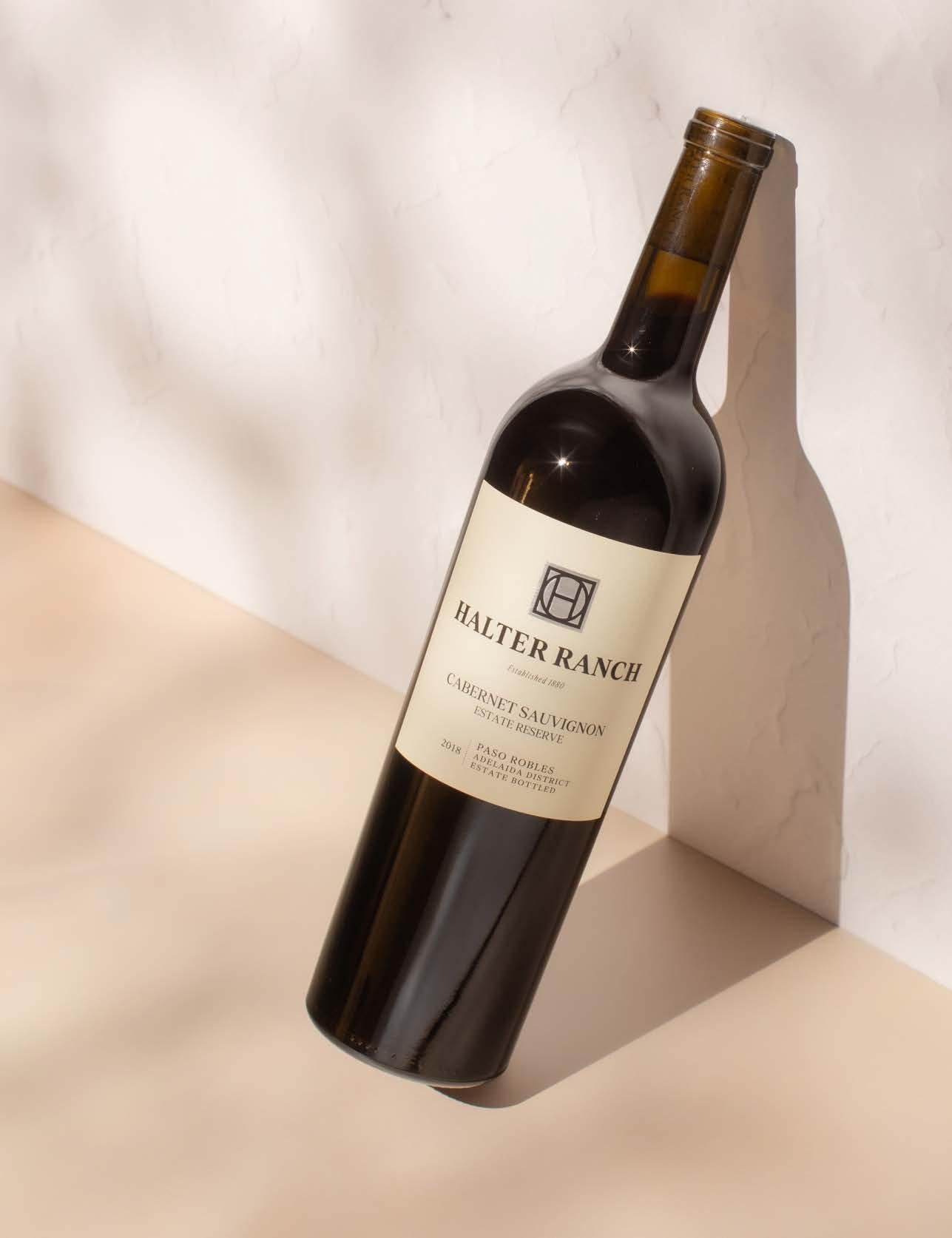






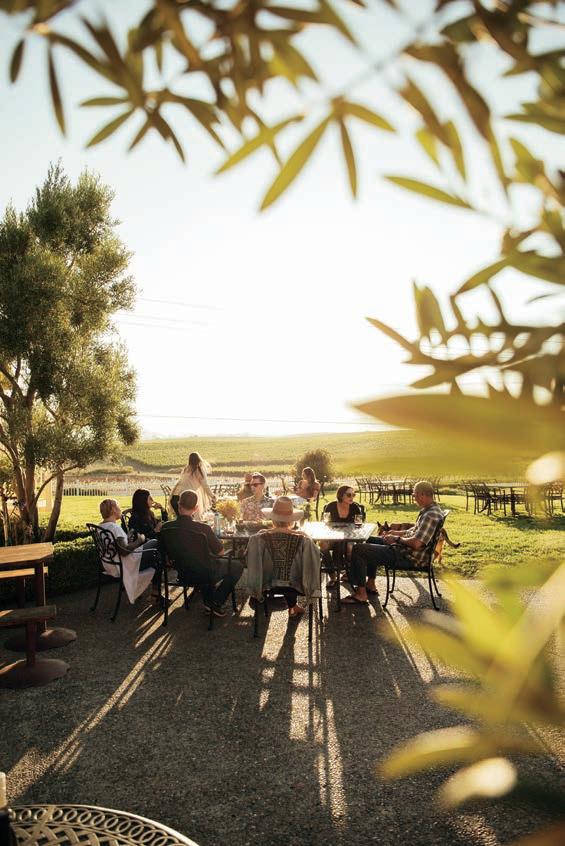







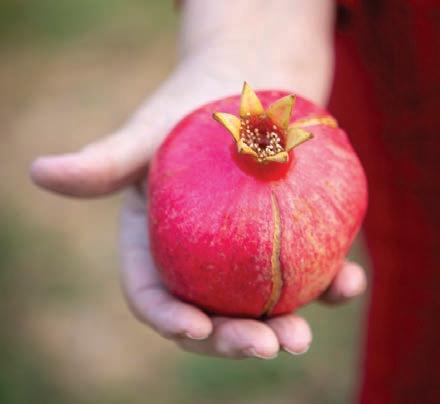






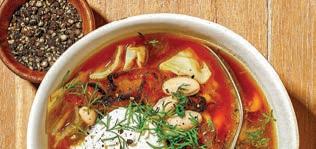






PUBLISHER
Shop Talk LA, Inc.
Gail Cayetano Classick gail@edibleslo.com
MANAGING EDITOR
Aja Goare aja@edibleslo.com
ART DIRECTOR
Chandra Wroblewski
COPY EDITOR
Doug Adrianson
WRITERS
Katy Budge, Aja Goare, Katie Herzog, Brenda Hock, Dakota Kim, Jonathan LaFerrara, Scott Lewis, Lindsey Mendes, Reid Phillips, Renee Ror, Lauren Yoon
PHOTOGRAPHERS
Lee Ibarra, Sarah Kathleen, Mary Lagier, Hugo Martinez, Gennan Shippen, Sean Stromsoe, Ruby Wallau, Jennifer Young
ILLUSTRATORS
Jenna Hartzell, Anna Takahashi
RECIPE DEVELOPER
Rachel Ponce
SOCIAL MEDIA
Stephen Heraldo
DIGITAL EDITOR
Dustin Klemann
COVER ART
Photographed by Sarah Kathleen at Angela's Pastries in Paso Robles
EVENTS
Uli Billington, Brittany Gregory
GENERAL INQUIRIES info@edibleslo.com

An apple floats in a barrel of water as children with their hands folded behind their backs take turns chomping at it. Young bystanders shout as the one up to bite, so to speak, submerges their face into the water in an effort to secure the coveted fruit. Several misses only inspire more vigorous gnawing until — at last — teeth make contact with a mighty crunch. Victory has been had.
Bobbing for apples was a favorite fall contest for me and my middleschool friends. Never mind the risk of germs — we were in it to win. That’s because my friend’s dad would reward the winner with a delectable caramel-covered apple and, of course, bragging rights.
Now, as an adult, I don’t participate in games where winning requires making a face like a horse mid-whinny. But I do still enjoy a caramel apple. This ritual of fall signifies it’s time to mull wine, carve pumpkins and cue up Hocus Pocus on TV. The season is effortlessly cozy, prompting soup for any given meal and the wearing of flannel by those beyond lumberjacks, scarecrows and 1990s Abercrombie models.
Whether your fall routine involves dressing the kids (or yourself) in a daring Halloween costume, traversing a corn maze or simply using the oven more often for meals, this issue of EdibleSLO is all about rituals. These are actions that we find ourselves repeating year after year for the sense of comfort and nostalgia that they evoke. For Angela Rivera, it’s the cake from Mexico that reminds her of childhood and now serves as accompaniment to morning coffee. To Annette Ausseresses, it’s the annual witches paddle out that she organizes in Morro Bay. And diners at The Loading Chute would likely argue that a steak and fresh bread at dinner is the feather in the cap after a day of wine tasting. Chef Rachel Ponce hopes to add some new rituals to our lives with some delicious and creatively plated cauldron foods.
There is certainly no shortage of serious topics to cover these days, considering the threats imposed by ever-changing federal policy, and we will continue to shed light and share stories from the farmers, chefs and makers who battle through it to put food on our tables. But we hope that a little bit of levity with the lighthearted nature of these themed topics brings some joy to you and your family. It’s never too late to create your own rituals and maybe that means bringing a new business into the fray. Keep connecting, keep sharing, and don’t stop supporting our community producers.
Sincerely,


Aja Goare


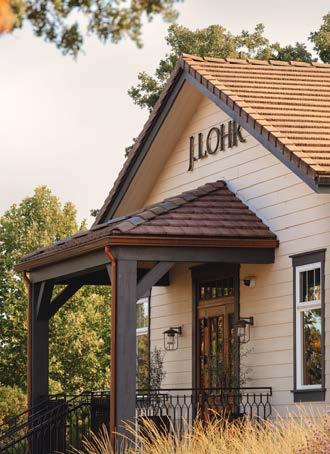
Paso Robles is one of the world’s great winegrowing regions
– it is a special place the Lohr family and J. Lohr Vineyards & Wines proudly call home. Guests visiting the newly reimagined J. Lohr Paso Robles Wine Center will find warm hospitality, dramatic vineyard views, and legendary wines in the farmhouse-inspired setting.
The seasonal tasting experiences offer many J. Lohr winery-exclusive gems and hard-to-find, small-lot releases that are only available here, “at the source.”
BY LAUREN YOON
Packed inside a turkey or layered over cubes of bread for a savory stuffing, fall herbs are pillars of the Thanksgiving table. Though they are commonly associated with the annual November holiday, sage, rosemary, thyme and parsley have a myriad of uses, health benefits and ancient histories within their leaves.
Sage, with its pebbly, oval leaves and woody stems, is planted in the spring or fall, in areas with mild winters. Rosemary’s needle-like shrubbery is evergreen in mild climates such as California, but normally planted during spring in areas prone to frost. Thyme, a plant that can produce several varieties from a single batch of seed, should be planted in full sun for the best flavor. Delicate parsley, which comes in flat-leafed or curly varieties, is best planted early spring through late fall.
All four herbs are native to the Mediterranean and widely harvested and used during the fall and winter seasons. They date as far back as ancient Egypt and were considered sacred during Roman times: Sage purportedly provided health, wisdom and immortality; rosemary was worn in hair apparently for improved memory; thyme is believed to have cured poisons and given strength to soldiers before battle; and parsley, in a gesture of reverence, was placed on winning athletes and tombs of the dead.
Today, the herbs are used in cooking and for medicinal purposes. Sage is often added to sauces for bold flavor and into marinades of fatty meats, especially pork and poultry, because of its bright, peppery taste. It is also said to stimulate antioxidant defense systems and be anti-inflammatory, according to the National Library of Medicine. Rosemary’s spicy, distinct flavor lends well to stews and roasts and is believed to cure headaches and fatigue. Thyme can help elevate pasta sauces and roasted vegetables with its clove-like flavor; its oil has antimicrobial properties that inspired its use as as a preservative. Parsley brightens and adds a pop of color to any dish and has been used as a diuretic.
Sage, rosemary, thyme and parsley may be best known for supporting the heavy dishes that make up Thanksgiving spreads, but they shouldn’t be relegated to a single category. The rich history, versatility and special aromas of these fall herbs make them essential additions of flavor for daily cooking. So, skip that mysterious “dried herb mix” in the pantry that’s surely passed its prime and opt for these fresh, green bundles of the season.
J. Lohr is “Pure Paso Robles® Book your reservation today online JLOHR.COM/VISIT
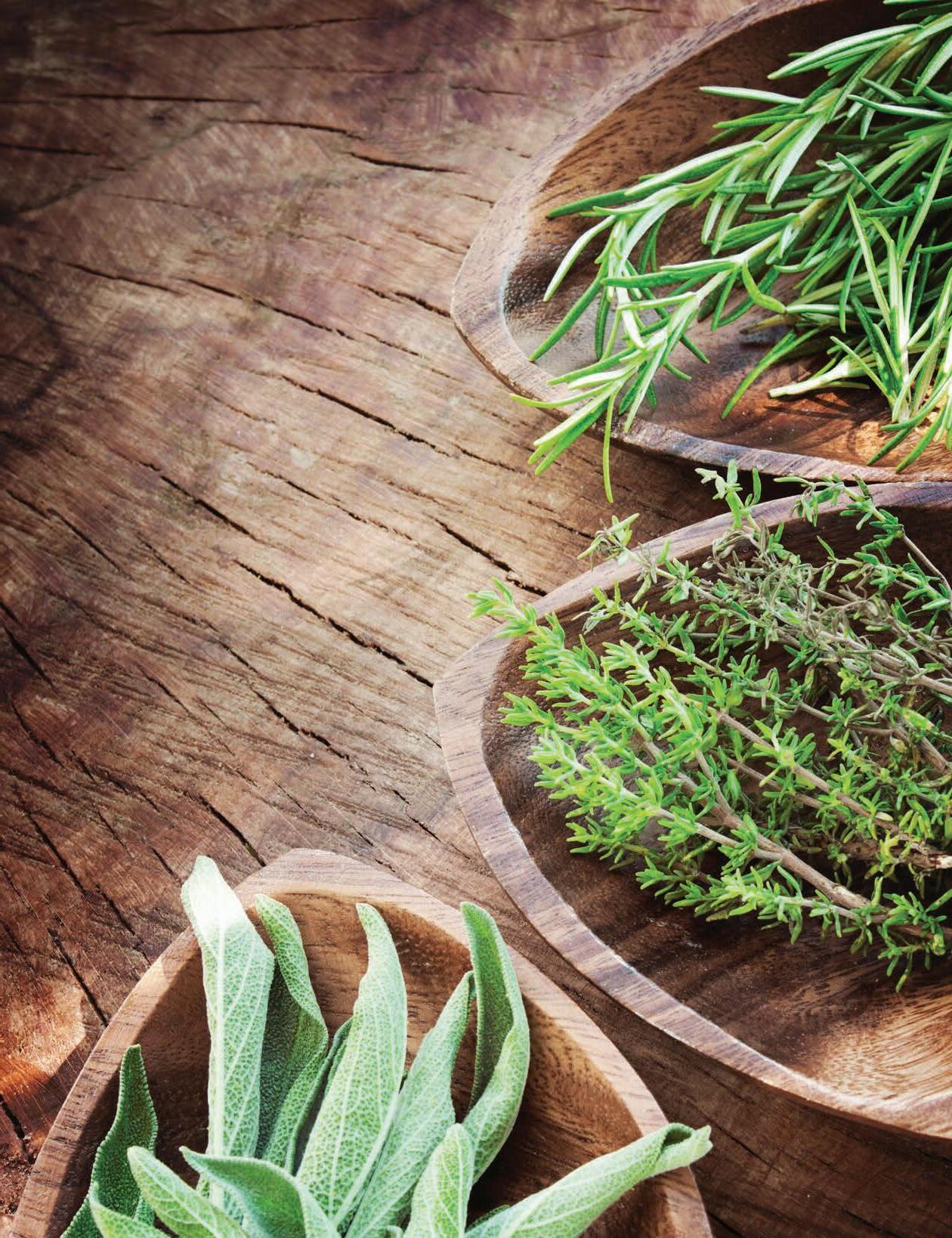
Starters to entertain the mouth and the mind.
BY RENEE ROR


photo by Andrew Cobb
San Luis Obispo is abuzz about the arrival of Wren, which officially opened in early May. The excitement centers around local Chef Kimi Walker Ahrens, a restaurant veteran of over 20 years, who is running the show alongside husband Mike Ahrens. Wren is open in the evenings with a menu of seasonal small plates and a thoughtful wine and beer list (daytime hours are coming soon). A current standout on the menu is the seasonal crudo made of fresh ahi tuna with soy lime ponzu, Persian cucumbers, local microgreens and crispy shallots. Set in a beautifully restored brick building — formerly home to I&I Kitchen — Wren marks the couple’s first brick-and-mortar venture. It’s the realization of a long-held dream: to create a small, welcoming spot where Kimi can share her passion and deep knowledge of food with the community. The menu shifts often with the seasons, so there’s always something new to try.
1901 BROAD STREET IN SAN LUIS OBISPO WRENPROVISIONS.COM @WREN_PROVISIONS
Certified tea sommelier Jen de Tréglodé has long cherished tea — not just as a beverage, but as a living tradition rich in cultural history, healing properties and connection to well-being. A host of many tea ceremonies in San Luis Obispo, her relationship with tea deepened when she discovered living tea. She describes it as wild or biodynamically grown from seed, rooted in ancient soil and cultivated with care and reverence; true tea from the Camellia sinensis plant that is unmatched in quality. Now through Sacred Mountain Teas, Jen sources and shares single-origin, biodynamic living teas, many of which are being introduced to this region for the first time. Each one is grown by small, independent farms from the tea regions in Japan, China and India that are committed to traditional, ecological practices.



Area marketing and media relations consultant Sean Weir, who has worked to help many of the wine and craft beer brands of SLO County achieve recognition, has now found himself in the spotlight as the author of The Mad Crush. An unvarnished look at the winemaking process set around the actionpacked 1995 harvest season, the book dives deep into themes of perseverance, mentorship and the countercultural heritage of the Central Coast dating back to the late 1800s. It’s now available as an expanded second edition. Order a copy in print or on Kindle on Amazon, and at Saucelito Canyon Vineyard in San Luis Obispo.

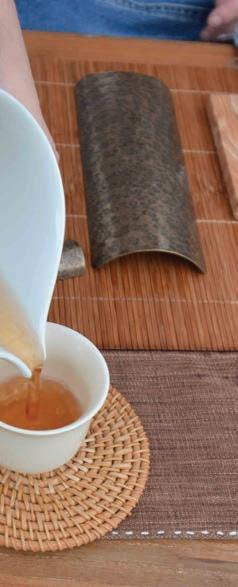

New to the beachside food scene in Cayucos is Mosey’s Burgers, a smashburger-style restaurant from Mark Mantel and Jeremy and Ellen Sizemore, the same team behind restaurant Pie in the Sky just around the corner. They’ve taken over the iconic corner space that was once home to Surf Rat Donuts and, before that, Ruddell’s Smokehouse. Mosey’s serves simple, high-quality burgers made with local ingredients and zero seed oils. First time visiting? Start with the Classic Smashburger and a side of crispy fries.
101 D STREET IN CAYUCOS @MOSEYSBURGERSCAYUCOS
The Environmental Center of San Luis Obispo has been actively expanding the urban forest through its ECOSLO Urban Tree Planting program. In collaboration with community members and local municipalities, the organization introduces trees into public spaces using a “right tree, right place” approach. Beyond initial installation, ECOSLO also provides essential maintenance and care for the first three years of each tree’s life to ensure healthy growth and long-term success. This ongoing effort supports the City of San Luis Obispo’s goal of adding 10,000 trees by 2035 — a target aimed at combating climate change, strengthening communities and promoting biodiversity.
ECOSLO.COM @ECOSLO

Gen Z now has a wine club all its own thanks to Vina Robles Vineyards & Winery. Their Rookie Club is positioned to bring fresh energy and new faces to the Paso Robles wine scene. With spirited monthly events like Swiftie bracelet-making, trivia game nights, wine tasting 101 and presale access to Vina Robles Amphitheatre concerts, sips (their approachable wines ring up under $40) and socializing are the name of the game here.
1650 RAMADA DRIVE IN PASO ROBLES
VINAROBLES.COM
@VINAROBLESWINERY



New nanobrewery and taproom Shrine Brewing has been pouring out pints in Duncan Alley since March 1. When Owners Joe and Justine Florence opened the doors, they made good on eight years of planning and passion. A clean and modern space with an industrial edge and bold design touches, most notably a mural by LA-based artist Shrine (no relation), reflects the couple’s interest in vibrant patterns and boutique aesthetics. Shrine Brewing offers a rotating selection of beer, currently pouring IPAs, a pale ale, brown ale and pale wheat ale; a Pilsner and Munich Dunkel are on the way. After graduating from the American Brewers Guild, Head Brewer Joe Florence completed an apprenticeship at Firestone Walker Brewing Co., where he met Co-brewer Max Lachowyn, bringing serious craft beer credentials to every pour.
3197 DUNCAN ROAD IN SAN LUIS OBISPO
SHRINEBREWING.COM
@SHRINEBREWING


Trending retreat destination Sagrada Wellness is recognized for its weekend-long yoga, meditation and wellness experiences focused on providing a deep reset in a short amount of time. A highlight of the Santa Margarita retreat is its culinary program: health-forward, mostly plant-based menus. There are no microwaves in the kitchen, nor are there seed oils in the pantry. Organic ingredients are sourced from the San Luis Obispo and Templeton farmers markets to complete scratch-made dishes that support a holistic and nourishing diet. Fresh herbal teas are hand blended with mountain rose herbs and served daily.
SAGRADAWELLNESS.COM
@SAGRADA_WELLNESS
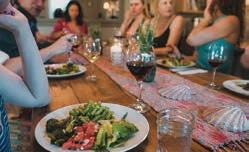


Excerpted from Good Things by Samin
Nosrat
This perfect vinaigrette recipe comes from Via Carota, the charming West Village restaurant run by Jody Williams and Rita Sodi. Since I first wrote about it in 2019 in the New York Times Magazine, it’s become indispensable not only for me but also for my entire Culinary Brain Trust, who now simply call it House Dressing.
The warm water in the recipe might surprise you. “We add warm water to make it more palatable,” Jody told me. “Pure vinegar is just too strong—it assaults the taste buds. We want a salad dressing so savory and delicious that you can eat spoonfuls of it. We want you to be able to drink it!” I recommend drizzling this dressing liberally over everything from boiled asparagus to farro salad to steak and fish and roast chicken. And if you don’t have both types of mustard on hand, just use twice as much of whichever you have.
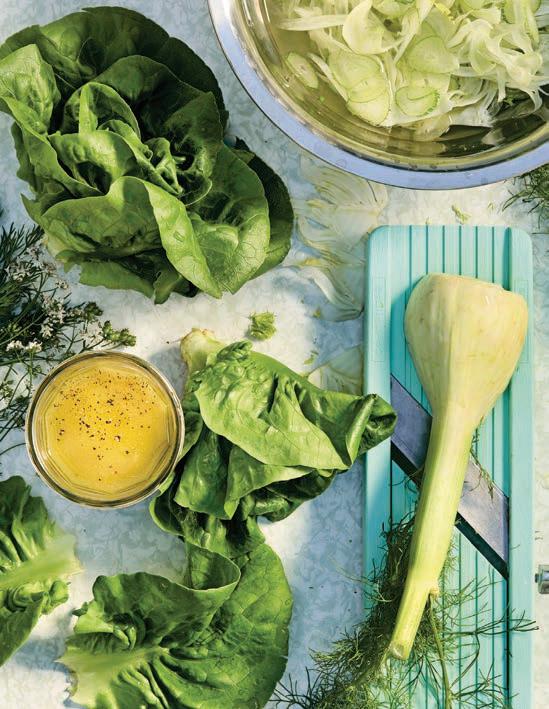

½ teaspoon freshly ground black pepper
Place shallot in fine-mesh sieve and quickly rinse with cold water. Allow to drain. Place in medium bowl, add vinegar and warm water, and let shallot mixture sit for 2 minutes. Whisk in oil, honey, mustards, thyme, garlic, salt and pepper. Taste and adjust salt and vinegar as needed. Cover and refrigerate remaining dressing for up to one week.
Edible Managing Editor Aja Goare and Samin Nosrat,



















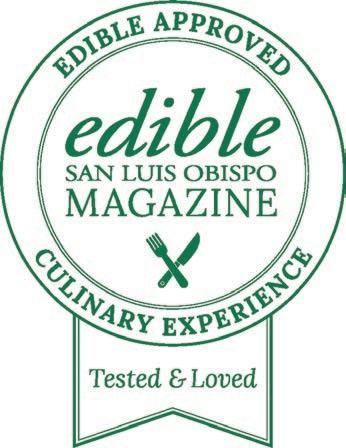
Look for this badge on all Edible tested and loved foodie experiences around the county!

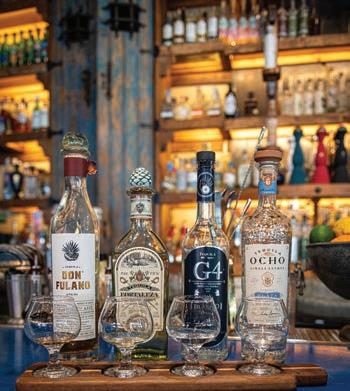
There are many journeys to experience at Margarita Adventures, including the popular Zip ’n Sip (ziplining, plus wine tasting). Of them all, our favorite is the understated foraging excursion. Here, we explore nature’s snack aisle on foraging tours through historic Santa Margarita Ranch. Led by Ranch Naturalist Jackie Redinger, learn the ancient art of identifying a variety of wild, edible plants used for food, beverage and health practices, and embrace foraging as a cultural practice that remains deeply relevant in this modern age.
IN SANTA MARGARITA. margarita-adventures.com/ nature-wildlife-tours @margaritaadventures
Fish Gaucho and its sister restaurants
Cane Tiki Room and Pappy McGregor’s have their culinary options dialed in, but we’re here to share the lesser-talked-about yet brilliantly curated Gaucho Flights. Sip your way through Mexico by diving into mezcal and tequila flights highlighting the depth and diversity of Mexico’s iconic spirits — from smooth Blue Weber tequilas to rare, small-batch mezcals made from wild agaves like Tobalá and Madrecuixe. Go with one of the handpicked mezcal and tequila lineups or build your own for a totally custom experience.
IN PASO ROBLES. fishgaucho.com @fishgaucho
Trek through a historic ranch on a foraging adventure. Taste your way through the mezcals and tequilas of Mexico. Throw a seafood dinner party of your dreams. Made for experience seekers, here is Edible’s annual bucket list of culinary adventures that welcome us to dig deep into the food- and drink-scape of local culture.



When the first The Pottery location opened in Atascadero, we couldn’t get enough. Apparently others couldn’t either. Our favorite workshop for handcrafting gorgeous, functional tableware can be experienced at any of The Pottery’s now three studios across the county. The six-week course teaches how to design and build well-balanced plates, bowls and serving pieces that feel great in your hands and look stunning on the table. Expect hands-on demos, personalized design guidance and plenty of studio time — plus pro tips for refining pieces for everyday use.
IN ATASCADERO, BAYWOOD AND GROVER BEACH. thepotteryatascadero.com thepotterybaywood.com thepotterygroverbeach.com
Join Christiana Christian of Christiana’s Preserves, whose jams are sold at some of our favorite shops throughout the Central Coast (looking at you, Neighbors General Store and Bodega Los Alamos) for a jam session like no other. Yes, the edible kind!
These interactive jam-making classes take place at picturesque farms, cozy kitchens and scenic wineries around San Luis Obispo County, where you’ll transform peak-season fruit into tasty preserves using time-honored techniques. Spots fill up quickly, so when you see one — sign up.
christianainthekitchen.com @christianainthekitchen
When done right, a seafood dinner at home feels like a little coastal escape: fresh, elegant and indulgent. The secret is securing high-quality ingredients; that’s where Giovanni’s Fish Market & Galley comes in. The Morro Bay staple known for serving the freshest local seafood for over 40 years also offers a wide selection of wild-caught fish, shellfish and specialty items available for overnight shipping to all 50 states. Even if you can’t make it to the waterfront fish market for the day’s freshest catch, you can still savor a slow, delicious evening that brings the ocean to you.
IN MORRO BAY. giosfish.com
@giovannis_fish_market
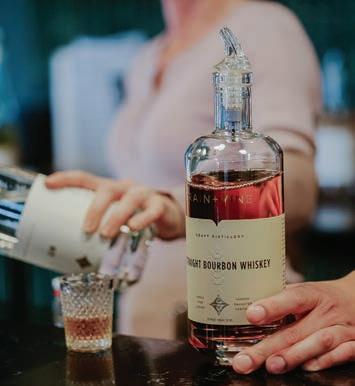


A drive through Paso Robles wine country always calls for a stop at Barton Family Estate’s epicurean haven, where food, wine and whiskey come together. We love it because you can choose your own adventure around the property: Sip rare library wines pulled from deep in the cellar, paired with onsite chefprepared bites; roll up your sleeves for the Grain + Vine barrel-to-bottle whiskey exploration, an immersive course in the art of distilling; or, for a more casual outing, make a lunch reservation for a meal on the sundrenched courtyard patio.
IN PASO ROBLES.
bartonfamilywines.com
@bartonfamilyestate @grainandvinedistillery
When it’s time to treat ourselves, we indulge with Chamisal Vineyards’ signature bubbles-and-caviar experience, set against a sweeping view of the vines. There is nothing quite like popping open a bottle of their estate sparkling wine and pairing it with a tin of Sterling Royal grade caviar (that’s the silky, flavor-packed kind we can’t get enough of) served with crème fraîche and chips. It’s an elegant pairing and the ultimate nosh that makes us feel like royalty.
IN SAN LUIS OBISPO. chamisalvineyards.com @chamisalvyd

For the second time, Kulturhaus Brewing Company’s fermentation classes have made this list; the classes are just that cool. Taught by Co-owner Jen Harris, a fermentation enthusiast who loves helping others become confident in traditional methods of preserving food, some of the classes are hands-on and guests leave with their own jar of fermented foods. Others are demonstration only. So choose what fits your personality and learning type. With either, you’ll get samples and take-home material to serve as guidelines when you put your learnings into practice at home.
IN PISMO BEACH.
kulturhausbrewing.com
@kulturhausbrewingcompany
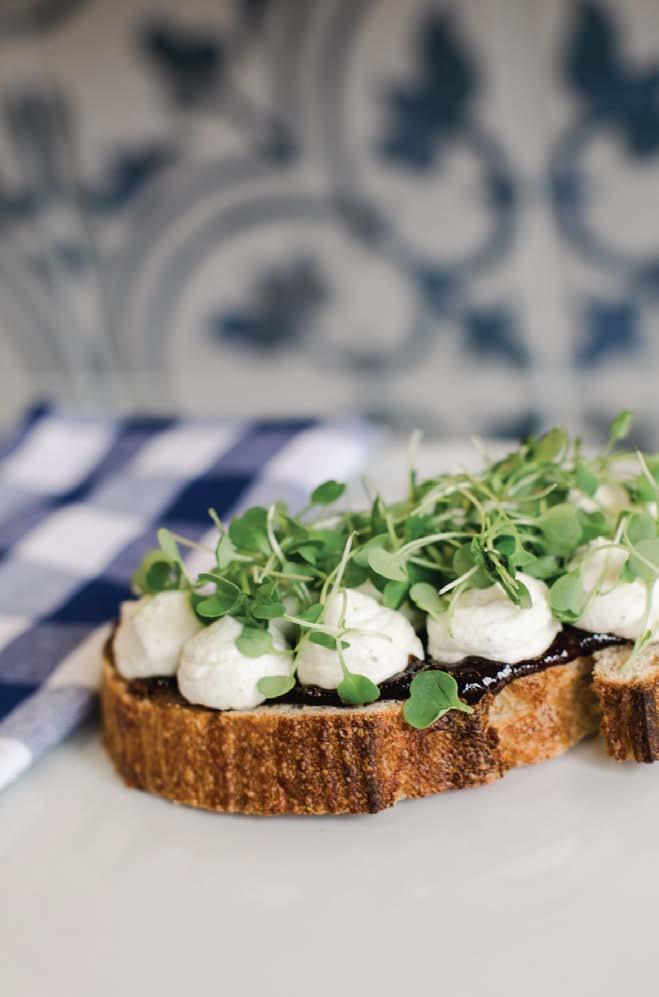



These autumn recipes are devilishly delightful.

As the summer heat fades and cardigans reemerge as dinner attire, mealtime shifts with the season; roasted, spiced and glazed become the season’s go-to cooking techniques. Paired with a glass of mulled wine or mug of warm apple cider, these recipes are enchantingly rich and full of seasonal flair.

BY RACHEL PONCE PHOTOGRAPHY BY HUGO MARTINEZ

SERVES 8
As autumn creeps in and the days grow darker, few ingredients feel quite as cozy as potatoes, and this recipe of chicken croquettes is a clever way to resurrect leftover mashed potatoes. The dipping sauce casts a spell of bold, herby flavor. These croquettes are not only perfect as an appetizer or quick snack, but can also serve as a satiating main dish when paired with a fresh side salad. Serve on a family heirloom for a haunting effect.
INGREDIENTS
2 cups mashed potatoes
1 cup cooked and shredded chicken
¼ cup prosciutto (optional)
½ cup grated cheese (mozzarella, Cheddar or Gouda)
1 teaspoon garlic powder
½ teaspoon dried oregano
1 teaspoon salt
1 egg, beaten
1 cup Italian breadcrumbs
Black sesame seeds
Vegetable oil for frying
For the dipping sauce:
Sour cream
Pesto
Step 1
Combine in large bowl the mashed potatoes, shredded chicken, prosciutto, cheese, garlic powder, oregano and salt. Mix until well combined. Add beaten egg to mixture to help bind it. If mixture is too wet, add a few more breadcrumbs to help firm it up. Use a tablespoon or small ice cream scoop of the mixture to shape into balls. Roll each croquette in breadcrumbs, ensuring they are well-coated for a crispy exterior. Press some black sesame seeds into the top for added effect.
Step 2
Heat oil in a deep skillet or frying pan over medium heat (use enough oil to half-cover the croquettes). Once oil is hot, carefully add croquettes in batches, being careful not to overcrowd pan. Fry until golden brown on all sides, about 3–4 minutes per side. Remove croquettes from oil and place on a paper-towel-lined plate to drain excess oil.
Step 3
Combine equal portions of sour cream and pesto in bowl. Arrange croquettes on a platter and drizzle sauce over top. Serve hot.

The scent of warm apple cider is unparalleled this time of year; here, its sweet and tangy notes meld with savory pork, creating a balance that warms the soul. This showcases the juiciness of the pork, enhanced by a glaze that caramelizes in the oven and drips down the meat. The spellbinding aroma of simmering cider with freshly chopped herbs and spices makes a wonderful centerpiece for a cozy family dinner or a festive gathering with friends.
For the pork loin:
2–3 pounds pork loin, trimmed
For the apple cider glaze:
2 tablespoons
Step 1
Preheat oven to 375 degrees F. Pat pork loin dry with paper towels. Season generously with salt, pepper, garlic powder, onion powder, thyme, rosemary and Dijon mustard, rubbing spices into meat for even flavor. In a large oven-safe skillet or Dutch oven, heat olive oil over medium-high heat. Sear pork loin on all sides until browned, about 3–4 minutes per side, to lock in juices.
Step 2
While pork sears, make glaze: Combine apple cider, brown sugar, apple cider vinegar, cinnamon, salt and nutmeg in saucepan. Bring to simmer over medium heat and let cook for about 10–15 minutes, or until it reduces slightly and thickens. Stir in butter until melted and well combined.
Step 3
Once pork is seared, pour half of apple cider glaze over pork loin in skillet, reserving the rest for later. Transfer skillet to preheated oven and roast for about 25–35 minutes, or until internal temperature of pork reaches 145 degrees F. During last 10 minutes of cooking, brush pork loin with reserved apple cider glaze to create a shiny, flavorful coating. Once pork is cooked, remove from oven and let it rest at least 10 minutes before slicing (this helps retain juices for moistness). Slice pork loin and serve drizzled with remaining apple cider glaze.
Tip: Pair with roasted root vegetables, mashed potatoes or a fresh apple salad for a complete meal. Leftovers make for a tasty sandwich.

A bubbling pot of vibrant red sauce might conjure thoughts of Dracula, but rest assured: This dish has plenty of garlic. A luscious blend of tomatoes, red wine and a hint of spice makes for a complex yet simply made pasta sauce. With its deep flavors and toothsome texture, this recipe provides its host — er, diner — coziness from the inside out. And though the hammer in this scene might remind you of the horror classic Misery, we promise this dish is nothing but pleasure.
2 tablespoons olive oil
1 medium onion, finely chopped
2 cloves garlic, minced
1 carrot, finely diced
1 celery stalk, finely diced
1 pound ground beef (sub, other ground meats or mushrooms)
1 (14-ounce) can crushed tomatoes
2 tablespoons Calabrian chili paste (adjust to preference)
2 tablespoons tomato paste
½ cup red wine
1 teaspoon dried oregano
1 teaspoon dried basil
1 teaspoon salt
½ cup beef or vegetable broth
12 ounces spaghetti (Etto Pastificio preferred)
Salt for pasta water
Grated Parmesan cheese, for serving
Step 1
In a large skillet or saucepan, heat olive oil over medium heat. Add onion and cook until translucent, about 5 minutes. Add garlic, carrot and celery; and sauté for 5–7 minutes, until softened. Increase heat to medium-high and add ground meat. Cook until browned, breaking it apart with a spoon. Drain any excess fat, if necessary. Stir in tomatoes, chili paste and tomato paste. Pour in red wine and let simmer for a couple of minutes, until slightly reduced. Add oregano, basil and salt. If sauce is too thick, add beef or vegetable broth to reach desired consistency. Reduce heat to low, cover, and simmer about 30–45 minutes, stirring occasionally. The longer it simmers, the better the flavors meld.
Step 2
While the sauce is simmering, bring a large pot of salted water to a boil. Cook spaghetti according to package instructions until al dente. Drain, reserving a little pasta water.
Step 3
Toss drained spaghetti with Bolognese sauce, adding a splash of reserved pasta water to help it adhere, if necessary. Serve with grated cheese.


















BY AJA GOARE
Sheaths of black fabric hover above the water, pointed hats pierce the foggy air: Something spooky is afloat on Morro Bay. It started as a small Halloween-season birthday celebration among friends: a paddle out dressed as witches. The spectacle inspired curiosity and intrigue among bystanders and — with a bit of magic, perhaps — it led to a major annual event that draws thousands to the socked-in sea town.
“I personally love seeing the excitement with all the witches and warlocks,” says Annette Ausseresses, one of the founding witches who now organizes the paddle out. “Sometimes we pine for the days of old when it was just us, but it’s a fabulous sight. Being inclusive is a fun thing to do. The enthusiasm and smiles make it worth it.”
Annette and her girlfriends started the paddle out in 2013 to celebrate the Halloween-time birthdays of a few women in the group. Many of them had become friends through outrigger racing. The outdoor recreation enthusiasts would start the day with a hike, then hit the water. “A woman from Portland happened to see us on the bay in our costumes and thought it was really cool,” Annette recalls. “She went home and launched a witches paddle out in Portland and recognized San Luis Obispo for being the first.”
That recognition enchanted the news media and led to locals asking Annette if they could participate in the following year’s event. When she posted about it on Facebook, interest took off.
“It used to just be the 12 of us. Now, we average about 500–600 paddlers with at least a thousand spectators on shore,” says Annette. “People come here from Los Angeles and San Francisco and show up early for a good spot.” Similar events have since cropped up around the world in such places as Mexico, Canada and Abu Dhabi, capital of the United Arab Emirates.
Once considered the “off season” for tourism, the October event has brought a swell of visitors to Morro Bay. And after a day on the water, a witch needs to eat — no, not toads or spiders. If they’re not having a waterfront potluck with Champagne, Annette and her friends will frequent Tognazzini’s Dockside Restaurant after the paddle.
“Sometimes you get the wispy fog and it’s really amazing, surreal when the event goes on,” says restaurant Owner Mark Tognazzini, who runs the business with his son. “You can see the witches from the patio. The energy is exciting.”
Mark has operated the bayside restaurant for 21 years, bringing to the table fresh-caught fish from his own line. “We had started marketing catch directly off the boat in the mid-’90s, a kind of fish-to-table concept, before it was popular,” says Mark. “When you come in to eat, we can tell you not only when and where the fish was caught, but who caught the product.”
A longtime staple of the Embarcadero, Mark says he appreciates events that bring customers in to dine at his restaurant.
“We really encourage events like this — homegrown fun, grassroots. We love it,” he says. “It gives a chance for not only visitors but locals to come down and enjoy the waterfront. This event has exploded because people were having fun. It’s not driven by alcohol like a lot of events. It’s great any time you can have people dress up.”
And dress up, they do. Costumed attendees of all ages stand on paddleboards, sit in canoes and kayaks or lie back in boats. They start at Coleman Park and paddle to the yacht club, a laid-back journey that takes between one and two hours. “Wind and tide affect the duration,” says Annette. It’s in that vein that she suggests participants be mindful of safety and skill level. “If you’re not experienced and can’t swim, think twice about participating,” she warns, adding that a life jacket is always a good idea.
She notes that the literal paddle isn’t the only way for visitors to enjoy a little hocus pocus. The atmosphere among the community of people on the sidelines is, unto itself, an energized experience. Visiting one of Morro Bay’s many restaurants for some soup from their cauldron or a cold brew is half the fun.
“One of coolest things we do is let customers pick a fish out of the case and we prepare it, like a butcher shop would with meat,” says Mark. “We also do a deep-fried whole fish, which is a different style than anyone else, likely in the whole county. We’ve got fish tacos, clam chowder, smoked chicken and ribs, squid and chips for something more casual.”
Though the casual nature of the friends’ paddle out has become a bit more organized over the years, Annette says the spirit of the event remains: “It’s out of our hands now, but it’s still just a fun time with friends doing what we love to do.”




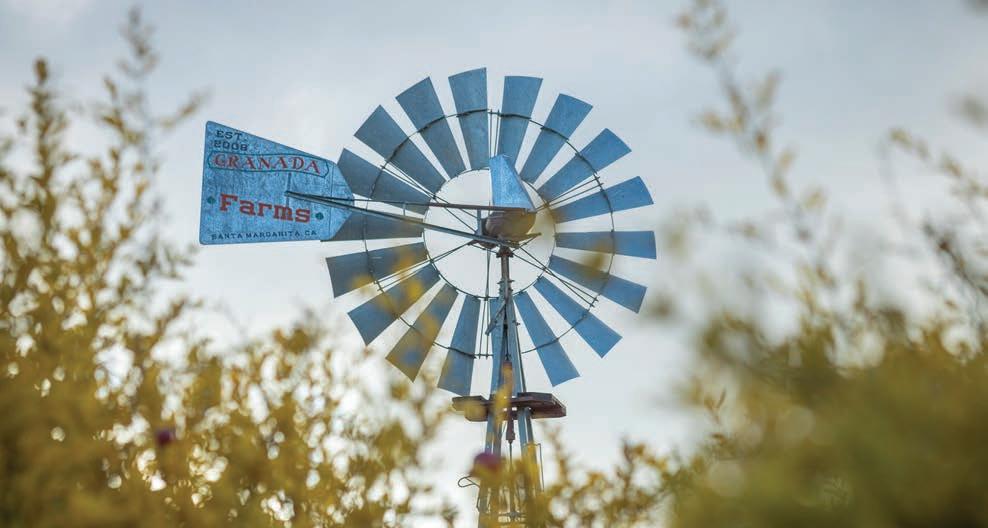

Santa Margarita farm grows sweet, tart crimson orbs.
BY JONATHAN LAFERRARA PHOTOGRAPHY BY

Many Santa Margarita residents remember when — not so long ago — the corner of El Camino Real and Murphy Avenue in downtown Santa Margarita was a vacant, trash-littered lot with sump pits in the grading. Today’s scene bears no resemblance, as that corner is now Granada Farms, a bright and well-cared-for pomegranate farm.
“We finally purchased [the vacant lot] in 1998. I tried to keep up with cutting the weeds to make it more presentable, but it was just a mess,” recounts George Sullivan, who procured the land with his wife, Debra. By a stroke of luck, they encountered developers of a parking garage project in San Luis Obispo who were trucking dirt to Paso Robles. “I asked, ‘Well, how much would it cost to dump the dirt on my corner?’ And they said it was on the way, so we could have it for free,” he says. “That’s when it went from an awkward plot of land to a very well-placed lot.”
The Sullivans started by planting 60 pomegranate bushes of the Angel Red variety, but the plants couldn’t withstand the freeze brought by Santa Margarita weather. From inexperience comes innovation; George and Debra then planted the Wonderful variety, which is less susceptible to freezing and relatively deer resistant. In went 124 bushes on amended soil with plenty of drainage and air movement. They were in business.
George and Debra worked steadily over the next few decades, darting between their day jobs, planning commission meetings and tending to the land. Pomegranates are a fall fruit, harvested as early as late October and into December, so the last months of the year are hectic. Typically, pomegranates ripen on the bush right before Thanksgiving, just in time for the fleshy, sweet bits of the fruit, correctly called arils but often called seeds, to be sprinkled on Turkey Day salads. Whole pomegranates are often used as decoration on holiday dinner tables, providing bright pops of fall color.
“Really, the ripest and sweetest pomegranates are when they crack. And at the end of their season, they crack open on the branch, and that’s how they propagate — the seeds drop to the ground and new bushes grow,” explains George. “[Some] customers especially love when the fruit is cracked, and very ripe and sweet. But we don’t wait for all of the skins to crack, because some customers want them really round, uncracked. Some buy them just for ornamental purposes. Some customers want the little bitty ones and make a necklace out of them. We try to have something for everyone.”
“we feel very accomplished to have planted and worked together on this, in this town...” of the earth
The fruit is harvested on weekends and sold right there on the farm. In slower years it could take up to seven weekends of selling to move through all Granada Farms’ inventory. Soon George will be retiring from his job in network operations at AT&T, and the stand will be open all week long.
“Debra and I will never need to be members of a fitness center because this farm is all the exercise we need — bending over, pulling weights, trimming, carrying,” he says of the intensive labor. Debra, a florist for over 40 years, compares pomegranate harvesting to picking fruit from a rosebush. Working with pomegranate bushes is like handling cactus branches; the quills can poke right through work gloves. Safety glasses are required and any picker knows that being jabbed by the plant is a given.
“It’s more of a ‘get healthy’ and a learning experience for us,” says George. “Definitely not a ‘get rich’ kind of way to make a living. But we feel very accomplished to have planted and worked together on this, in this town.”



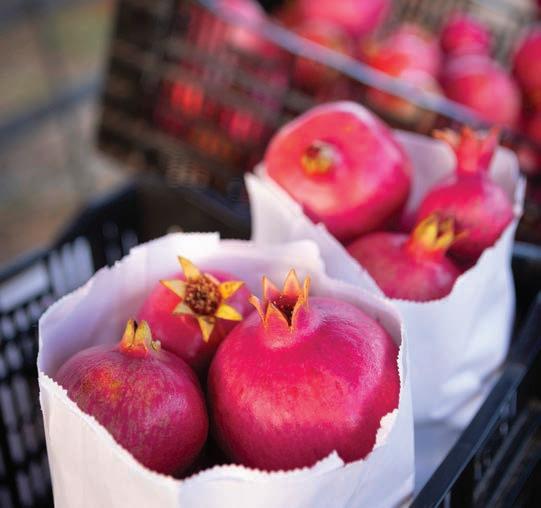
He continues, “It’s a town of mothers and fathers pushing their kids in strollers, and friends riding through on bikes, and townspeople getting in their golf carts and driving over to a restaurant. Or travelers from all over the world going down Highway 58 — we’ve had customers visiting from Ireland, the Middle East; you wouldn’t believe the diversity of visitors driving through Santa Margarita. It’s been a bunch of good people, who stop to ask what our plans are, what’s going on, what are we selling. We’re just very appreciative of this community.”

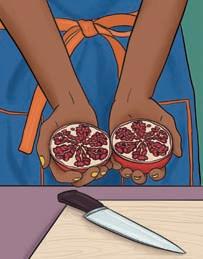
METHOD 1
The ‘panning for gold’ method: Slice off the crown (top of fruit, where it attached to the stem). Slice the fruit into four sections, exposing the white membrane. Pull apart the pomegranate over a bowl of water and use your thumbs to gently loosen the arils inside. They will sink to the bottom of water bowl. Skim off all the loose parts that float and discard them. Drain and eat the arils.
METHOD 2
The ‘dissection’ method: Cut off crown and score along the ridges. Peel apart where scored. Hold pomegranate sections with aril side on palm, and rind side up. Hit the rind with a wooden spoon so arils come out.
METHOD 3
The ‘hand it to the children’ method: Give this fun fruit to the kids and have them get creative finding ways to get to the sweet arils! (This is an outdoor activity, of course. And beware that the bright-red arils can stain hands, clothes and anything else, so use care.)


sustainably sourced
table adornments.
BY SCOTT LEWIS PHOTOGRAPHY BY SEAN STROMSOE
once considered a fading art in the age of mass production, silversmithing is experiencing a flicker of revival.
From heirloom-quality silverware to bespoke ceremonial objects and fueled by a growing appreciation for craftsmanship and individuality, this centuries-old tradition is stepping out of the shadows and into a renaissance of relevance. At the forefront is one of the few artists who can be called a master silversmith thanks to his generational training, background and experience: Randy Stromsoe is one of the last traditionally trained silversmiths in America.
There is no one quite like Randy. He operates out of Stromsoe Studios, his private studio in Templeton where Highway 46 meets Old Creek Road. “Randy makes each piece by hand. Period,” says his wife and business partner, Lisa Stromsoe, who has seen him design hand-forged flatware and holloware for as long as they’ve known each other.
For over 50 years Randy has apprenticed in and worked at shops with roots dating back to the early 1900s, collecting tools and carrying on the traditions passed down by the craftsmen he’s worked with along the way. His first big break came at age 19 when he apprenticed under master silversmith Porter Blanchard, “silversmith to the stars” whose customers included actors Joan Crawford and Cary Grant.
It was here that Randy immersed himself in the minimalist style of silver and pewter work, emphasizing simplicity and integrity of materials. Together they helped many families set their tables, making everything

flatware.

In these COnversations it is evident that Randy has a profound love for thE art of silversmithing, its deliberate detail.
from coffeepots to tankards to candlesticks. “We dealt with all the fine stores in the nation: Cartier, Gump’s, Neiman Marcus. All the places you’d register at if you were getting married back in the ’50s and ’60s,” says Randy. “Once I went to work for Porter, I never looked back. After he passed away [in 1973], I helped run the company for another [ownership] group.”
Over the decades, Randy has produced an array of handcrafted pieces — from presidential gifts during the Bush and Reagan administrations to ceremonial chalices for the Roman Catholic church — each reflecting a blend of historical reverence and contemporary design. His works have graced collections including the White House Collection of American Crafts, and the Renwick Gallery at the Smithsonian. His creations have been presented as diplomatic gifts by the U.S. State Department, symbolizing American artistry on the global stage. And, in a fun opportunity to be in front of the camera, he was one of only four California artisans featured on PBS’s television show “Craft in America.”
Despite a resume that reads like a fit for the upper echelon of society, Randy remains refreshingly approachable. “We’re not elitists at all. Anyone can call, make an appointment, and come over,” he says. Each October during National Arts and Humanities Month, the Stromsoes open their doors as part of San Luis Obispo County’s Open Studios Art Tour, a program of the SLO County Arts Council. Visitors are invited to step inside Randy’s workshop, the heart of his creative process, to see where the magic happens and engage in thoughtful conversations about his trade.
In these conversations it is evident that Randy has a profound love for the art of silversmithing, and its deliberate detail. “He can name every culinary piece of flatware, from a salmon slicer to an asparagus server, and he has made them all,” says Lisa. “To set a proper table takes about eight pieces of silverware minimum per person.” When meals were a more formal affair, the variety of flatware options were robust, from giant fish forks

to shallow mayonnaise spoons, from a 5 o’clock teaspoon to a bonbon spoon, and every type of charcuterie serving utensil imaginable. While demand for this kind of craftsmanship has seen a lull over the past decades among the mass market of consumers, chefs still deeply appreciate the attention to detail, says Lisa.
“Chefs want their creations to be celebrated. The food doesn’t stop in the kitchen; the presentation continues at the table.”
It’s no surprise then that chefs — artisans in their own right — connect with the dedication behind silversmithing. Both crafts demand precision, patience and physical effort; silversmithing, in particular, is as taxing as it is meticulous.
“It’s laborious and physical,” says Randy. “It’s taking a bar of silver and giving it 1,100 hammer blows to make one fork. It is hit 1,100 times in different directions, in different ways.”
Career longevity in silversmithing can be elusive but Randy offers a masterclass in both elegance and endurance. Now, as interest in the craft resurges, his staying power is finally getting its due. Long before the shift away from throwaway culture, Randy believed in an alternative — one where handcrafted work inspires, preserves a moment and honors a way of life. He stayed the course, letting his work speak — and serve — for itself.
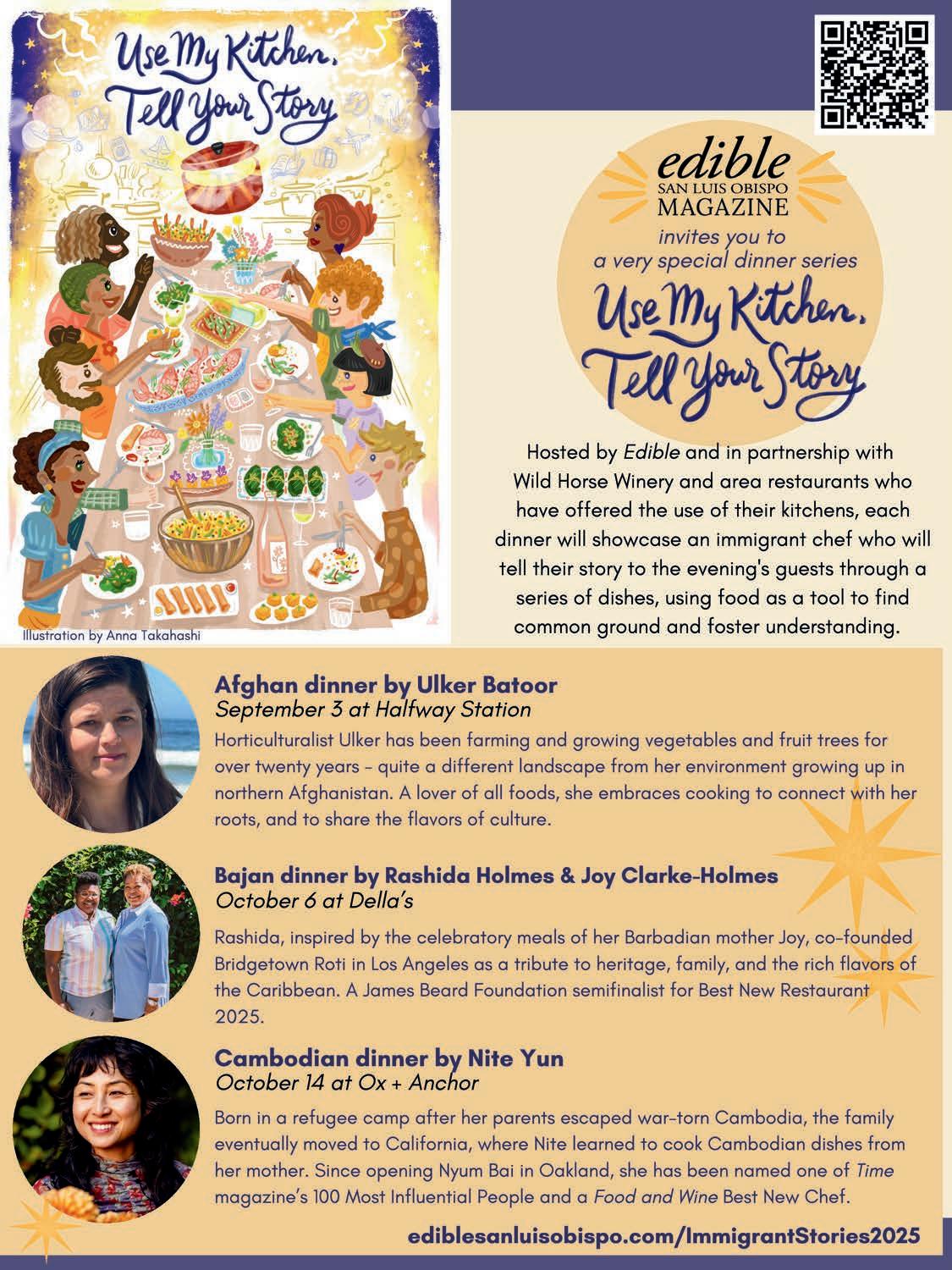

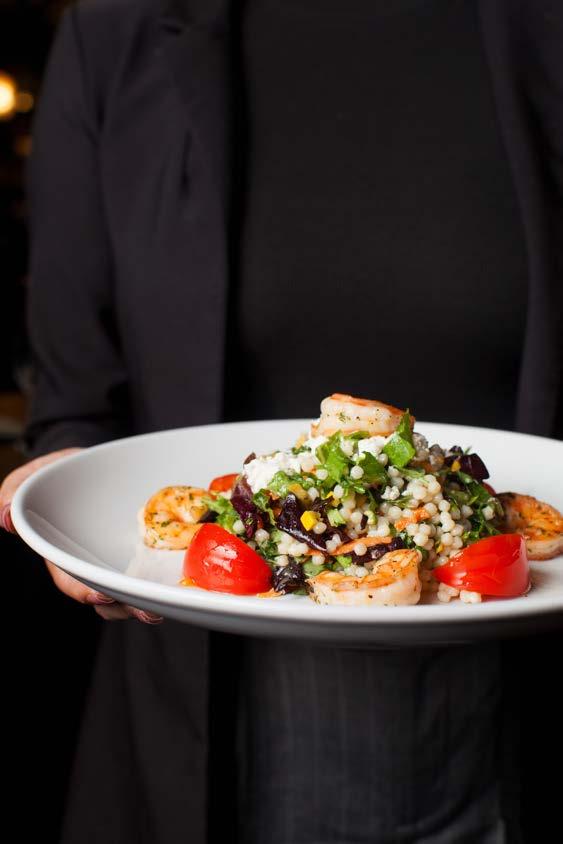
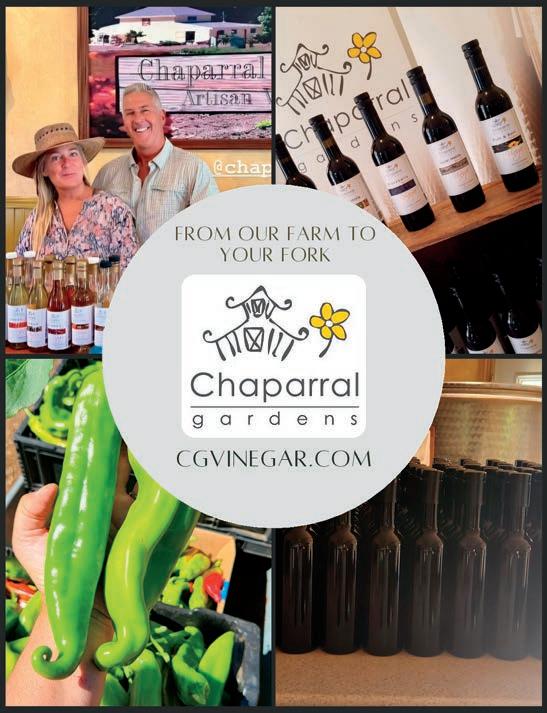

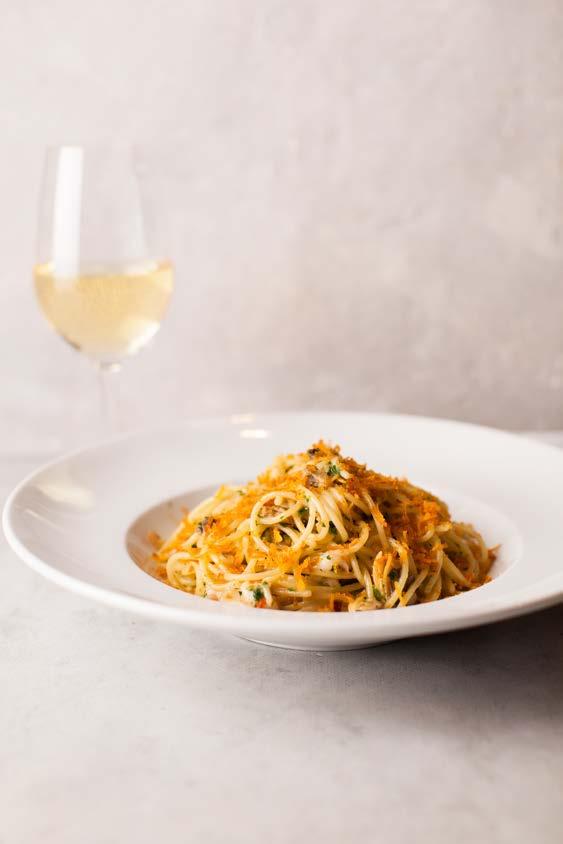







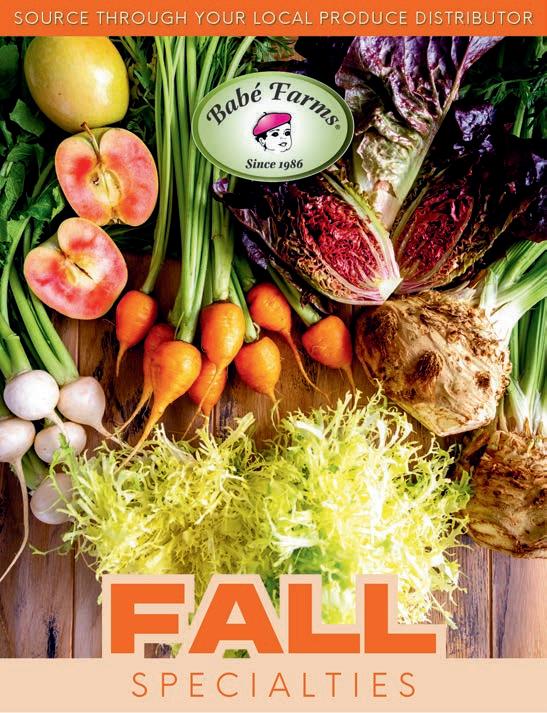
Tradition of harvesting walnuts continues at Fair Oaks Ranch.
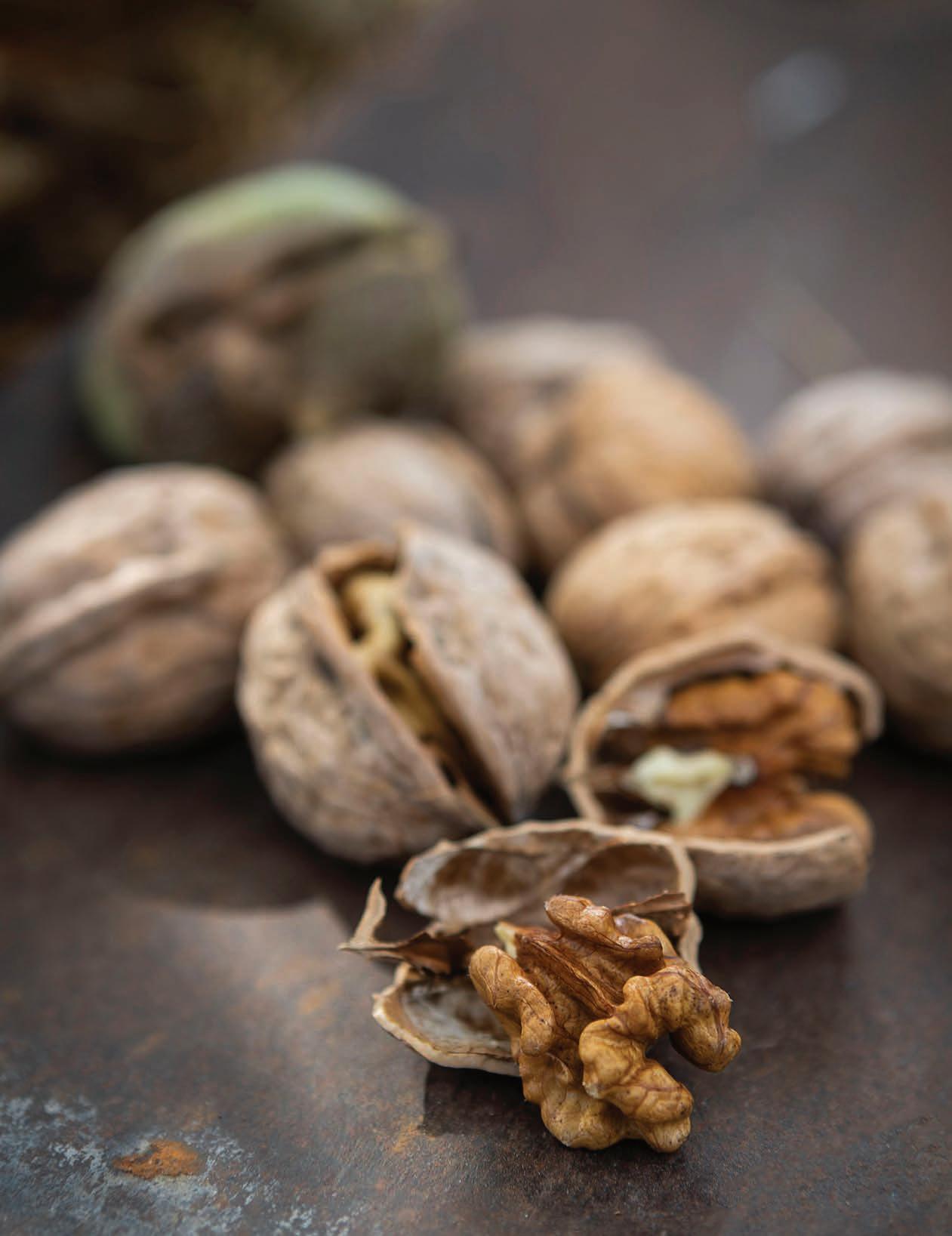
BY KATY BUDGE
BY GENNAN
For most of us, walnuts are conveniently found in plastic bags on grocery shelves. But harvesting these tree nuts is a complicated process, especially when done in the time-honored way practiced at Fair Oaks Ranch in Paso Robles.


Owned by Coco Collelmo and Sue Bowles, Fair Oaks Ranch gently sprawls over 735 bucolic acres in the Adelaida Hills. The property has been in Coco’s family for over 60 years, and its vistas evoke a timeless image of California rangeland. Hawks and turkey vultures swoop and swirl in the sky, while grazing cattle share the rolling landscape with deer, foxes, bobcats and even the occasional mountain lion.
There are also about 45 acres of majestic dry-farmed walnut trees, which were planted by Coco’s father soon after the family bought the ranch in 1959. He chose the Franquette variety because “of its ability to produce every year instead of intermittently,” says Coco. “And because their shells stay tighter, they stay fresh longer after harvesting compared to other walnuts.”
“There’s nothing like the taste of these right out of the orchard,” Sue adds, noting that the flavor is due in part to a lower tannin content in Franquettes. Tannin is a slightly bitter, astringent substance particularly associated with red wine. In walnuts, it’s mainly in the papery skin surrounding the nutmeat.
Franquettes are a French variety that date back to the early 1800s, according to website of Trees of Antiquity, an heirloom fruit and nut nursery located in Paso Robles. It also states that the “Franquette walnut [was] once the dominant walnut planted through the West.”
California grows almost all of the walnuts for domestic consumption, and produces over 60 percent of the global crop. However, these days most aren’t heirloom varieties such as Franquettes, and most certainly are not grown and harvested as they are at Fair Oaks Ranch.
As with many crops, heirloom walnuts have been pushed out of widespread commercial plantings in favor of those with bigger yields that can be brought to market faster. Varieties such as Chandler, Ivanhoe and Tulare now rule the roost, and most are grown in the fertile fields of the San Joaquin Valley.
But those trees are all irrigated, explains Coco. And they’re planted and pruned in such a way that they can be easily machine-harvested. Contrast that with the approach of Fair Oaks Ranch: entirely dry-farmed and hand-harvested.
Yes. Harvested by hand.
As November looms on the calendar, Coco and Sue start watching the weather reports for rain.
“The walnuts might be ready to harvest, but they will not come down or crack for release until we have a heavy fog or a slight to moderate rain,” Coco explains. “Moisture will start the harvest.”
Note that nothing has been said about “picking” the walnuts. Though they do indeed grow on trees, most of us would walk right past a ready-to-harvest walnut tree and not even know it. Like other tree nuts, walnuts are a bit of a Russian nesting doll. There’s a thick green outer hull that encases the shell, which encases the nut itself.
“When the weather changes and provides moisture, the outside hull cracks open,” Coco says. A shaker machine is then used to shower the walnuts to the ground.
“We hire 20–25 pickers to pick the crop up off the ground by hand, put it into three- to five-gallon buckets, and then into walnut sacks for transport,” she says. “A semitruck is loaded over two or so days, then shipped to the San Joaquin Valley to Poindexter Nut Company. They purchase our crop once we pay for hulling and drying at their facility.”
To say this is labor-intensive is an understatement, and that’s reflected in the final tally sheet for the Fair Oaks’ walnuts. “Labor is expensive, and can be extremely difficult to find,” Coco says. And because walnuts are a valued crop both domestically and worldwide, growers are subject to the vagaries of weather, tariffs, supply chain disruption and fluctuating crop prices. Given all those challenges, Coco and Sue won’t even know the final per-pound price they’ll be paid until the financial dust settles in the spring.
“Walnuts are certainly a commodity crop,” Sue says. As a result, “growing them is often not even a break-even deal, and in some years people have dumped their crop or pulled out their trees entirely.”
So why do Coco and Sue keep at it? Certainly part of it is to retain the rich agricultural tradition of their beloved Fair Oaks Ranch. But, as Sue points out, “as long as we can break even by paying people an honest wage to work, then we’re able to provide the community a healthy and delicious food.”

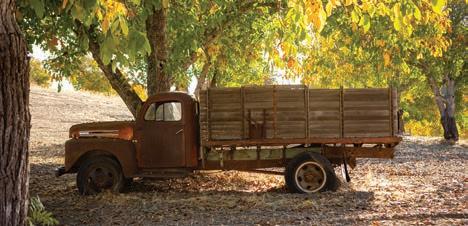

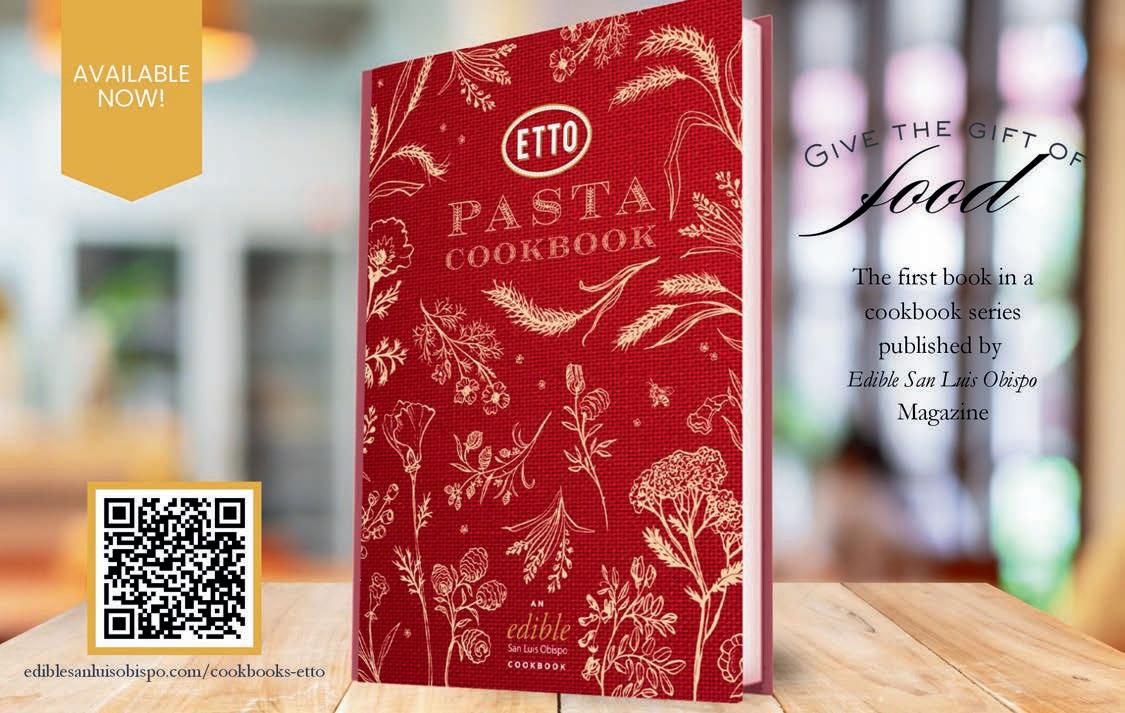


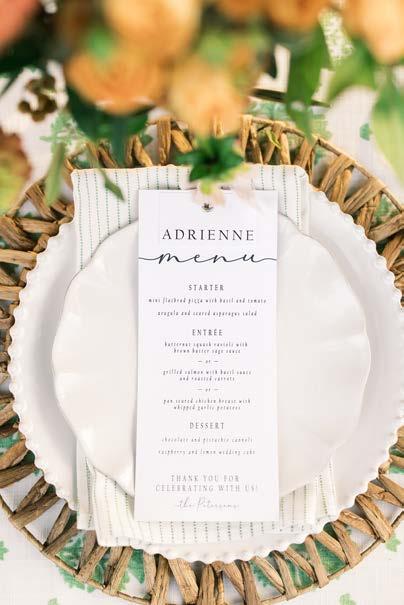


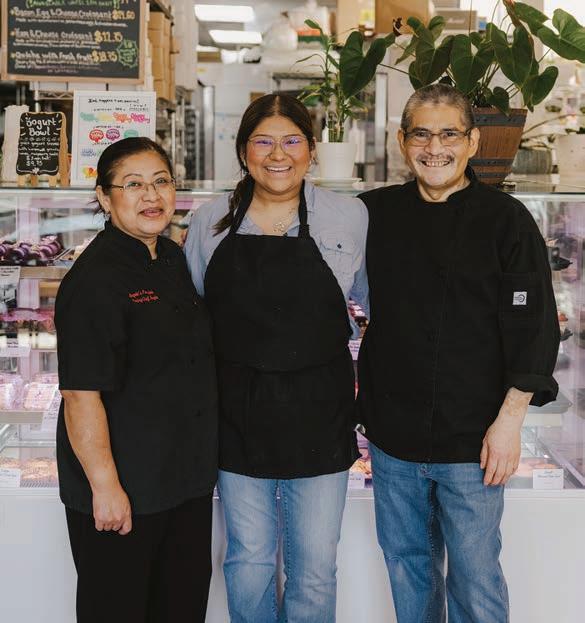


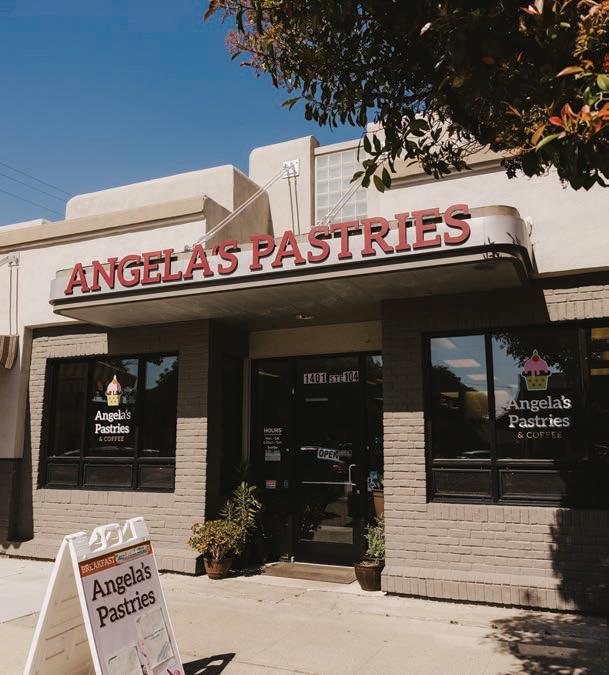
BY KATIE HERZOG PHOTOGRAPHY BY SARAH KATHLEEN
Opening the glass door to enter Angela’s Pastries in downtown Paso Robles is accompanied by the sound of an analog metal bell, an auditory indicator that sweet culinary delights await. A visit to the bright and welcoming space is a ritual for locals, as well as foodies passing through the area.
“There are customers who frequently drive between San Francisco and Santa Barbara who always stop here on their way,” says Antonio Perez, Co-owner of the shop. “[We] have lots of regulars whose order [the staff] already knows when they walk through the door.”
Antonio and his wife, Angela Rivera, have been baking together for the Paso Robles community since 2007. “We settled in Paso Robles after traveling through California in my 20s,” explains Antonio. “I loved the community, the quietness, the safety and the people. Angela and I knew that this town would be where we would love our family to grow up in.”
They began making cakes for friends and family. “I baked [my] first cake for my son’s eighth birthday, and have been baking ever since,” says Angela in Spanish. “He is now 31 years old.”
Confections hold a special place in the minds of children and remain part of our morning or celebration rituals throughout our lives. Many of Angela’s current menu items stem from her core memories of eating “slices of chocolate cake at the market in Mexico City, and tres leches at birthday celebrations,” she recalls. And a childhood introduction to pan, or bread, inspired Antonio for years to come.
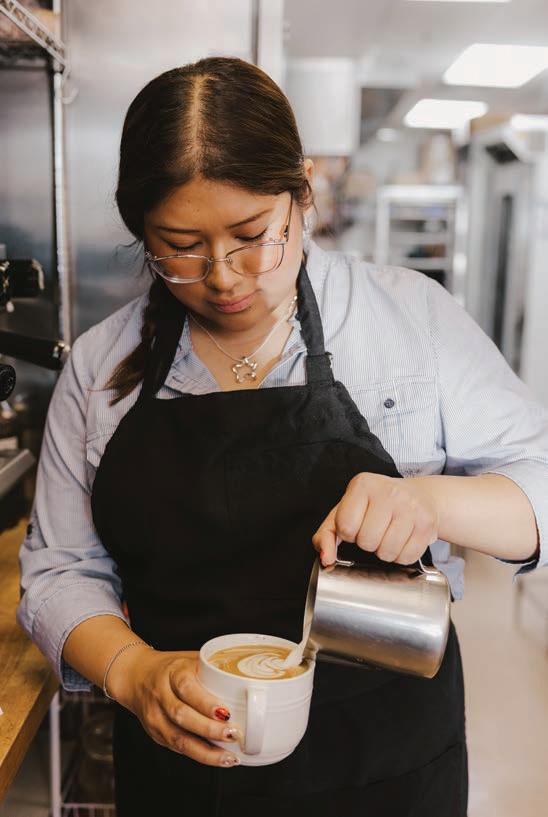
"My dream when I was a kid was that ‘When I grow up, I will have all the breads I want."
“When I was young, my favorite pastry was whatever bread I could get a hold of,” he recalls. “I lived in a small town; we didn’t have bakeries, so the bakers would come from other towns nearby to sell. Since we didn’t have a lot of money, we could only buy one or two for our family. My dream when I was a kid was that ‘When I grow up, I will have all the breads I want.’”
Those sweet memories are made into tangible desserts thanks to decades of experience in the kitchen. Angela baked with Pure & Simple for many years prior to starting her business, and Antonio’s expertise in French desserts stems from 12 years of work at the defunct Panolivo Family Bistro in Paso Robles. Angela and Antonio now supply local restaurants and caterers with baked goods, including the storied olive oil cake at Thomas Hill Organics.
Angela’s Pastries is the realization of a dream shared by the entire family. When their first brick-and-mortar bakery opened on Thanksgiving Day of 2015, it was a cozy spot on Spring and 18th Street. In 2022, they expanded into a larger space on Park Street between 14th and 15th Streets. Since its inception, the family has worked as a team. “The kids are always helping in everything we do. What we achieved, we did it together,” says Antonio, noting that their kids “work [at the bakery] on weekends to have resources for school.” Daughter Jessica Perez is pursuing a business degree at Cuesta College while she helps run the bakery.
The offerings at Angela’s Pastries include a wide variety of both traditional Mexican and French desserts, presenting a unique

cross-cultural education in global treats. A customer familiar with conchas or pan dulce — the traditional Mexican shellshaped sweet bread with a crunchy exterior — may encounter their first palmier — a crunchy, sugary French puff pastry in the shape of an elephant or pig ear. Similarly, a customer with a fondness for French macarons — a small sandwich cookie made from meringue and almonds with a filling — may delight in their first flan — a custard topped with caramel.
Cultural expressions shine through with seasonal offerings and custom orders that range from traditional French croquembouche wedding cakes, pastry puffs piled into a cone and bound with threads of caramel; to Rosca de Reyes, a sweet bread decorated with candied fruit that contains a baby Jesus figurine (whomever receives the slice with the surprise will be tasked with preparing the tamales for Día de la Candelaria on February 2). Customer favorites include daily offerings of Quiche Lorraine, lemon curd tart and the almond raspberry croissant, as well as seasonal offerings of Yule Log (also called Bûche de Noël), Pan de Muerto (for Day of the Dead), and Thanksgiving pies including pumpkin, bourbon pecan, apple and tarte tatin.
The expansion of the family-run business broadens the community’s access to the morning rituals found at tables around the world. The taste of a butter croissant transports us to France, and the empanada de piña (pineapple) to Mexico. The elevated quality and creativity that Angela’s Pastries strives for is evident in each bite. Now in their tenth year of business, the couple is grateful for the support of their community.








In this Perspective piece, a San Luis Obispo home cook and cooking instructor shares her experience as a food critic. Brenda Hock gives us a look behind the curtain at a career that was both coveted and challenging.
There was a time in my life when making dinner reservations was an act of espionage. I used different first and last names, foreign accents; one night I was a doctor, the next a divorcee. My hairstyles, like my accessories, took on personalities of their own. My companions — even my husbands — depended on the place and time. Back then, I was a restaurant critic avoiding detection in New York’s fine-dining scene.
I wrote a weekly column for nine years reviewing restaurants; each week, I penned 700 words and consumed 2 million calories. The writing consisted of a rating system of one to four stars for food, ambiance, service and value. But this system was not necessarily objective. On several occasions, I dined at restaurants where the food and service were, at best, mediocre, yet the New York Times critic had awarded them four stars. Was I brave enough to give an honest two or three stars? You bet. On one occasion, my bravery was rewarded with spite when a highly influential family took umbrage at my review and paid for a full-page rebuttal ad that accused me of incompetence. My husband at that time wanted me to get an unlisted phone number.
My inspiration for becoming a food critic was by author Jeffrey Steingarten’s book, The Man Who Ate Everything. He was an attorney who became the food critic for Vogue magazine. The book details how he set out to overcome his distaste for such things as kimchi, lard and Greek cuisine. When I started, I was a financial advisor with a degree from the French Culinary Institute, and an aversion to Indian and Mexican Food. The book was like a roadmap of sorts.
In terms of restaurant options, Poughkeepsie, NY, is not on par with Las Vegas or Manhattan. But this small town, home to telegraph innovator Samuel F.B. Morse, is also the headquarters of the Culinary Institute of America, so a lot of graduates open cutting-edge restaurants nearby. If green papaya carbonara with guanciale and a coddled quail egg is not your thing, you might prefer to dine elsewhere.
I had my share of peanut butter dust, lobster foam, cuisine minceur and the ever-present kale, radicchio and arugula. On the flip side, the wines of the Hudson Valley were darn good. As a matter of preference, I was inclined to award an extra star to any fine-dining restaurant where I didn’t have to pull out my French-Italian-English dictionary just to order.
Though I’d later become expert in concealing my identity as I investigated every detail of a restaurant’s food, façade and service, like any novice spy things started out a little rocky. It was Valentine’s weekend and I was dining at the ultra-romantic Troutbeck Inn. I was careful to be inconspicuous as I jotted down notes of their menu and specials onto a notepad on my lap. Or so I thought. Unfortunately, I realized at meal’s end that I had written all of my notes on their tablecloth.
There were lots of funny moments like that throughout my career, but the work was no laughing matter. A restaurant review can have a major economic impact on a dining establishment and I wielded my power with as much integrity and respect as possible; I always checked my facts with the owner, and if I was submitting a positive review, I gave the restaurant a heads up so they’d be ready with staff for an influx of customers. As reviewers — and today, that goes for Yelp and Google reviewers — we have a responsibility to recognize the power of the pen on local businesses. I made the decision to never review a restaurant where I had a bad experience. In my opinion, reviews are a form of advertising and I thought, “Why publicize a place that should be avoided?”
With the passage of time, it became apparent that no disguise would keep me from being recognized. I began to notice all the extras brought to my table: the samplings of amuse bouche, a multitude of desserts and visits from the chef. I figured into my reviews that my meal was likely the best they could offer.
My palate expanded as I swirled, twirled and speared entrée after entrée across nearly a decade of reviews. Despite my tongue’s displeasure in it, I couldn’t avoid reviewing cuisines I disliked. To be as fair as possible, I brought with me friends who enjoyed those cuisines and let them evaluate, while I stuck with chicken satay or fajitas.
At the end of 1999, I moved to California, where I found my food footing teaching cooking classes for the local Jewish community and talking about food on KVEC radio from 2000 to 2007. Those who tuned in to my “SLO Cooking” show know I steadfastly remain anti-cilantro, -goat or -feta cheese. I no longer review restaurants for a living, but I still enjoy dining out, except now it’s just as me, Brenda.


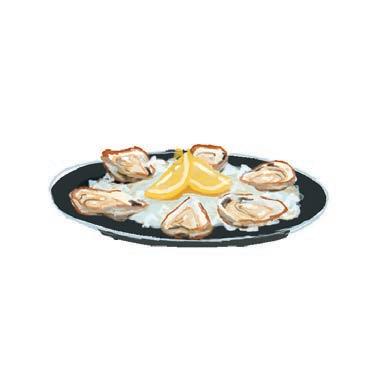



BY DAKOTA KIM PHOTOGRAPHY BY RUBY WALLAU
On busy nights, The Loading Chute on Highway 229 could double as Creston’s town hall. Loyal regulars along with a crop of wine tourists and visitors from nearby towns crowd the cozy ranch-style steakhouse, slicing into tender, oak-smoked rib eye over quality bottles like Presqu'ile Pinot Noir and Venteux Syrah. Set in the heart of tiny Creston, 10 miles from both Paso Robles and Atascadero, this family- and woman-owned restaurant is celebrating 25 years of service.
Since it opened in 2000, The Loading Chute has been a staple where “lifers” aren’t uncommon as front and back of house staff. “People consider our restaurant a community space, and we host everyone — winery owners, ranch owners, all the local people that run businesses in our area, even cowboys,” says Co-owner Dana Zepeda.
During the busy season, The Loading Chute flourishes as the only full-service restaurant on the Paso Backroads Wine Trail. The space buzzes with families on Mother’s Day and Easter, slinging biscuits and gravy and prime rib. At Christmas, the 1940s barn out back plays host to 50- to 200-person family reunions and parties. On sunny afternoons, diners flock outdoors to the newly renovated side patio while their kids play on the adjoining lawn.
Named for the cattle-loading mechanism that populated the property over a century ago, the restaurant is known for 21-day-aged Harris Ranch steaks cooked over a pit blazing with local red oak. But it might be just as beloved for its wood-fired French country loaf, a piping-hot accoutrement brought to the table, complimentary. Bakers churn out 50 to 100 loaves a day and guests can even grab a loaf to go. Until recently, Dana herself baked that bread daily. “At age 66, I have to let some others do the work,” she laughs.
Restaurants are labor intensive, and it’s not uncommon for some of them to buy their bread, sauces and desserts pre-made. But at this steakhouse, most products are made the slow-food way — with many of the condiments, sauces and dressings, including barbecue, teriyaki, ranch, blue cheese and blue cheese butter, thousand island and whiskey peppercorn — made from scratch. Desserts are also made in-house and served warm, topped with vanilla bean ice cream; those delights include bread pudding, mud pie, grasshopper pie and an off-the-menu secret: mixed berry cobbler.
“It’s not formal dining, but it’s full-service,” Dana says. “Two sides and the traditional bread and soup or salad come with the meal, and we’ve become a destination spot with folks out here wine tasting in Paso Robles or Atascadero, who want to come out to Creston and enjoy a nice day.”






So synonymous is The Loading Chute with Creston that the last page of the menu details the history of the town and the restaurant in the same breath. Creston was founded in March 1884, named after C.J. Cressy, one of four pioneers to purchase the 40,000-acre Rancho Huerhuero land grant. In the late 1800s, George Bell built The Loading Chute as a general store, supplying the town with clothing, groceries, hardware and horse and farm equipment; later, two families moved in and used the building as their home. In the 1940s, a frontfacing bar opened to the public, while residents continued to live in the back. The next decade left the building deserted, but Creston native Herman Heilman bought it in 1973, opening a café, saloon and grocery. The building changed ownership several times before burning down in a 1992 fire.
In 1999, Dana Zepeda bought the acre of land and renovated the building, reopening the restaurant on the eve of the new millennium. She now runs it with her husband, David Zepeda, who mans the oak pit, and her daughterin-law, Kristin Parker, who serves as their front-of-house and event manager for the barn behind the restaurant.
David learned butchery working in restaurants in Cambria, and hand-cuts the rib eyes. “My husband is probably the best grill cook in the county, I say — and a lot of people would say that,” Dana remarks proudly. “We also go through a lot of fresh salmon off the oak pit, which comes from a high-end Japanese company.”
The restaurant’s prime corridor is the front room, where guests sit sandwiched between the bar to the left, and the oak pit and pizza oven to the right. “People like to sit on that row right there to watch what’s going on,” Dana says. “You can watch David cooking the steaks on one side, and the pizza bubbling up on the other side.”
The Loading Chute may be known for its prime rib and rib eye, but Kristin loves their filet mignon with house-made whiskey peppercorn sauce. Other fan favorite entrées include the herb
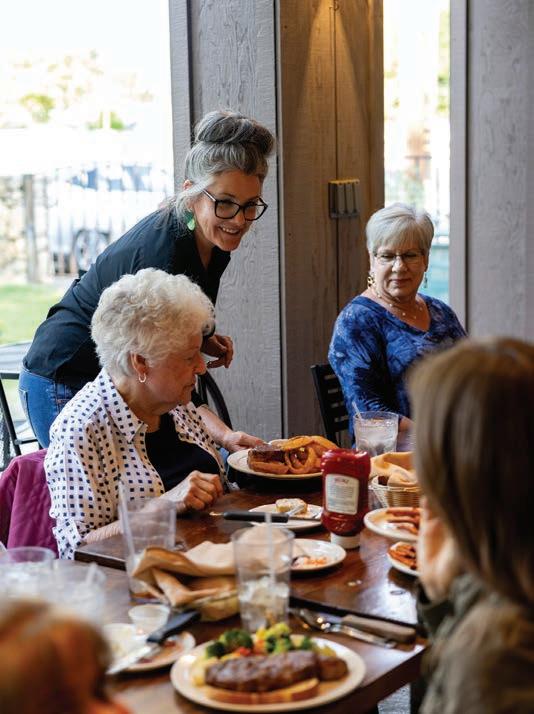
cheese chicken and rack of lamb, both of which are baked in a house-made rosemary herb sauce. Other favorites include the Ortega burger with grilled Ortega chile and chipotle aioli; the crispy Brussels sprouts, flash-fried and topped with goat cheese sauce, apple cider vinegar reduction and bacon; and the beef skewers with pepper and onion, basted in a house-made teriyaki sauce. Pizza is made from scratch with dough that’s hand-thrown into a 10-inch pie and cooked in one of the area’s first wood-fired ovens. All kids’ meals end with an ice cream sandwich for dessert.
In recent years, Kristin says the restaurant has gotten busier, and a newly renovated patio has let them expand their guest numbers. With 80 seats inside and another 100 on the patio, nice weather means a buzzing restaurant. Besides regulars who treat The Loading Chute like a second home, more tourists have come in recent years. She believes reliability and good value in an era of inflation account for some of the restaurant’s growth.
“Our service is great, our menu doesn’t change, and we’re open for lunch and dinner every day, so people never have to check our hours. People are always impressed by our large portions and we’ve also managed to keep our prices reasonable—I feel like you can’t get that at many other places.”
BY AJA GOARE PHOTOGRAPHY BY JENNIFER YOUNG
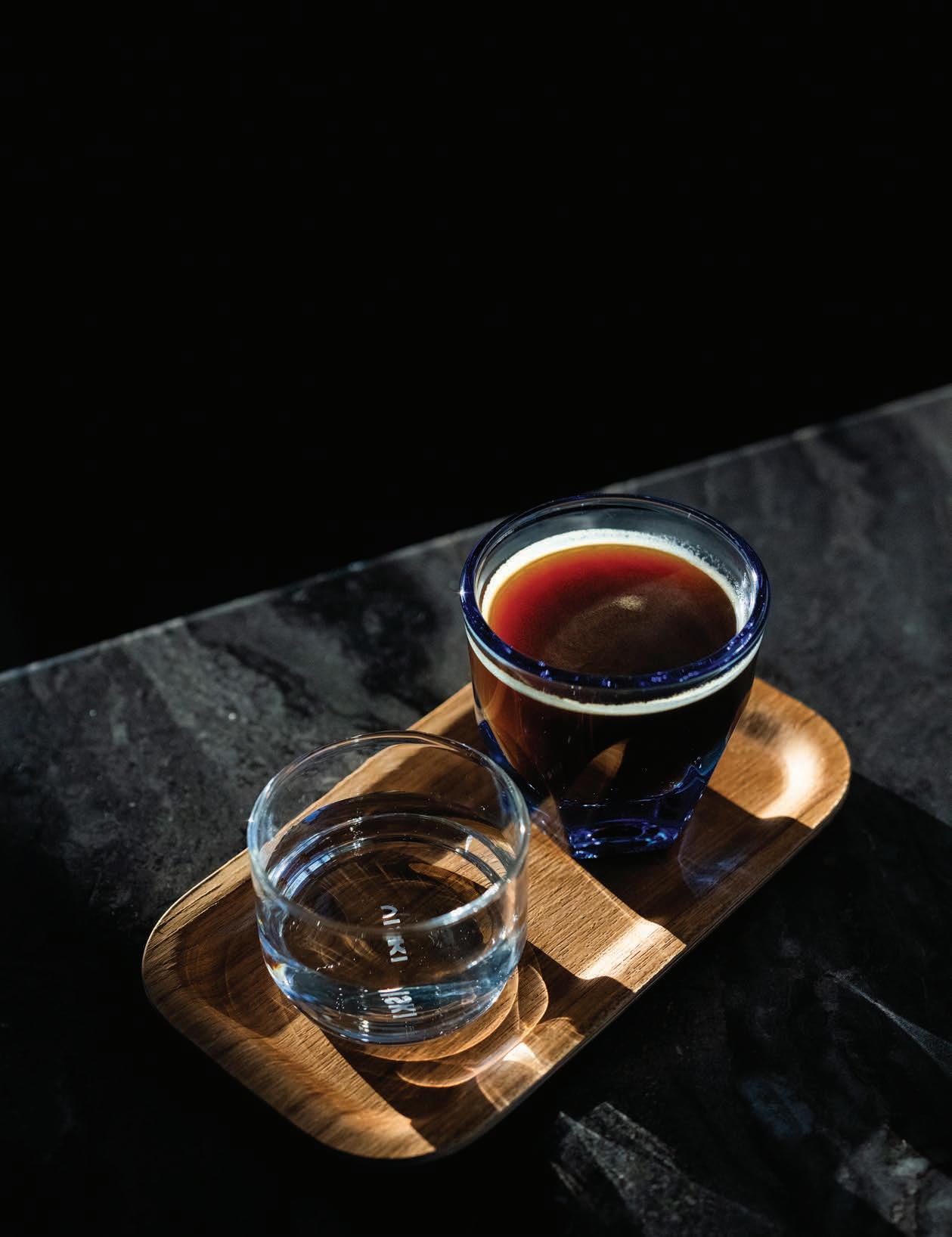
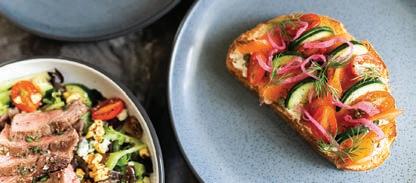

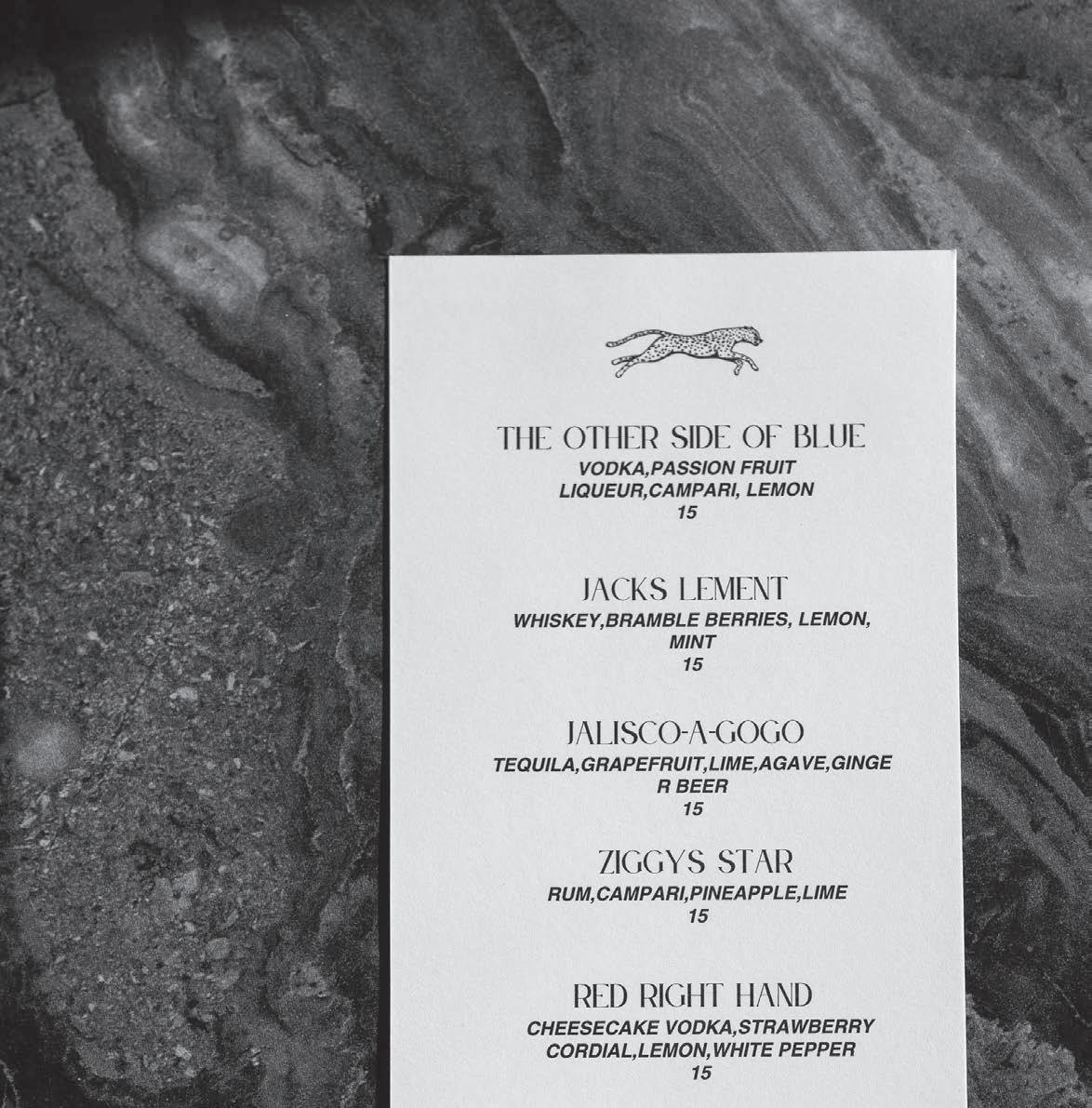

Working in the hospitality industry can be a thankless job for what tends to be low pay, leading to high rates of burnout. After eight years of this — at one point working three jobs to make ends meet — Andre Gorham decided there had to be a better way: his way.
He opened Twenty South in the SLO Public Market last November. As the founder, he manages a team of eight employees and focuses on creating an experience that’s not just good for customers, but employees, too. “I wanted to build the culture and team that I wasn’t able to have in the past,” Andre says.
Part of that culture entails nurturing a true sense of community. He says unlike other coffee shops he’s patronized, the interaction between customer and barista at Twenty South isn’t solely transactional. “If you order a drink for here, we actually bring it to you. While you’re here, we’re checking in on you, bringing water if it seems like you plan to stay longer,” he says. “I want guests to feel seen. I want them to feel cared for.”


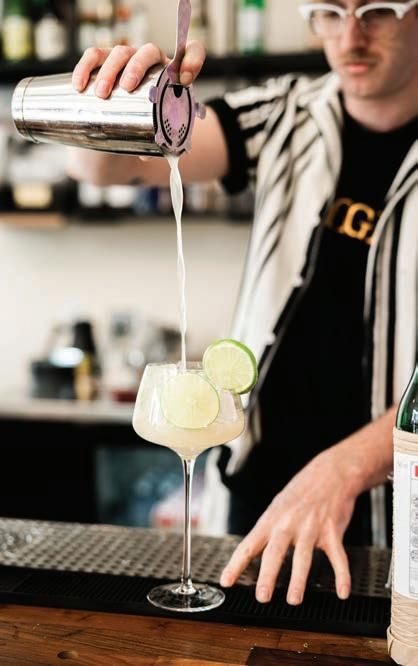

That includes complimentary hot chocolates for kids and tableside coffee refills. Andre believes hospitality took a backseat during the pandemic, when face-toface interactions were all but eliminated. The masked and distanced pandemic wasn’t the only time Andre yearned for connection. In his previous career in finance, his interactions were limited to “making people’s bank accounts bigger.”
Despite a reduction in pay, Andre says the shift in career has brought him purpose. “If I know I made your day with the perfect cappuccino — I steamed the milk just right and nailed the latte art — that makes me feel good,” he says.
“I know I just set you up for a good day.”
To make it an even better day, Twenty South offers cocktails and menus for all three meals of the day. Dishes prepared by Chef Steve Lucero, who has cooked for various Central Coast restaurants for 30 years, include salads, toasts, sandwiches, quiches and more. Eric Hunter runs the bar program and crafts cocktails with creative touches that pair well with entrees. “We want to be great at all three: coffee, cocktails and food,” says Andre. “Having good coffee and food is easy, but having great customer service is harder.”
Looking ahead, Andre plans to expand with new locations across the Central Coast.
“And we know that requires staff that’s passionate and really good at what they do,” he says. “So we do pay higher than minimum wage — we’ll take the hit now while we’re building, knowing in the future we’ll be in a better position for it.”

and celebrate our local food and drink community, season by season.




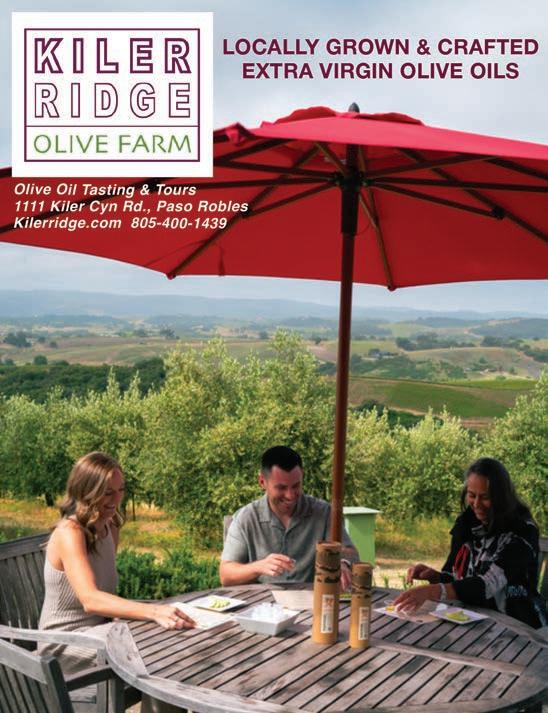






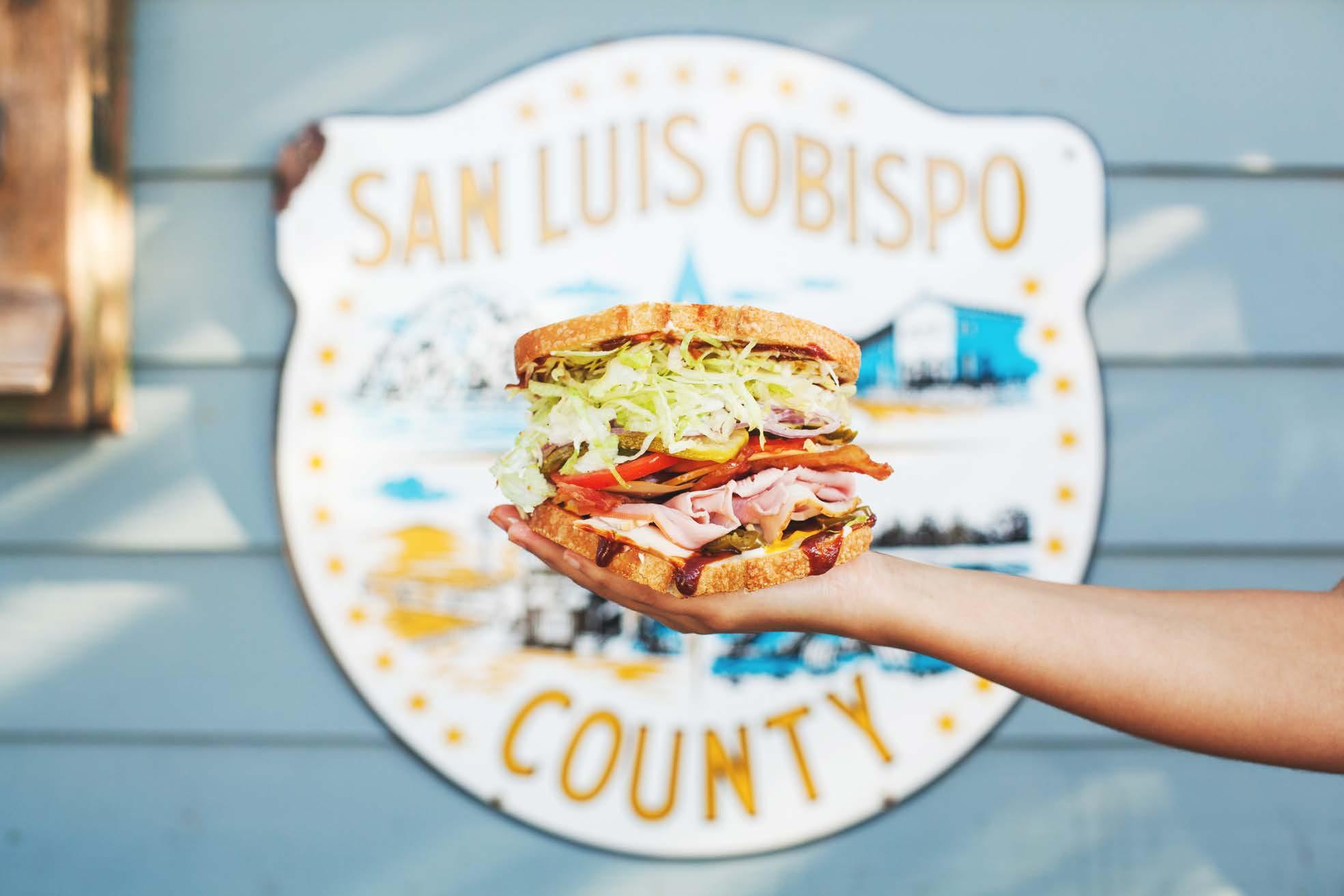


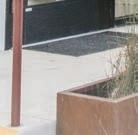

















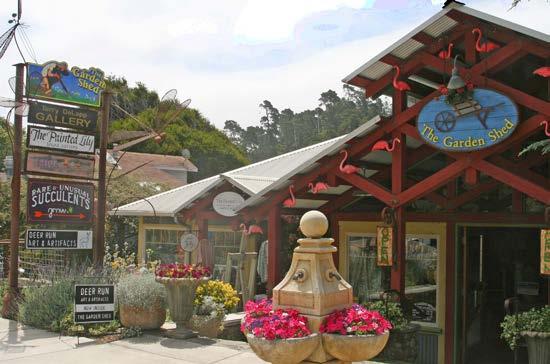









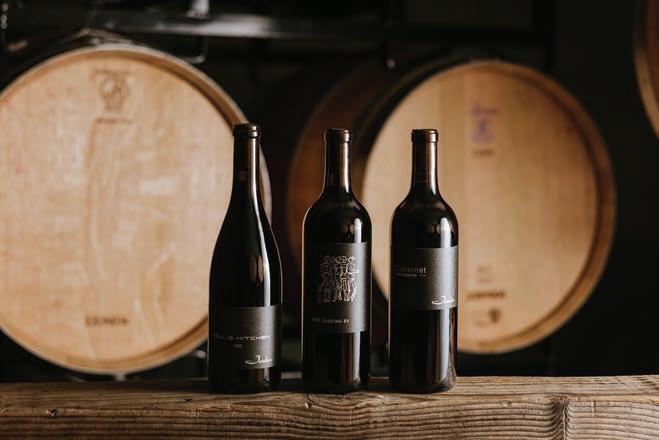

A showstopping charcuterie board is achievable. Here, Central Coast Creamery uncomplicates the building of a board with cheese tasting notes and pairings to get you started.
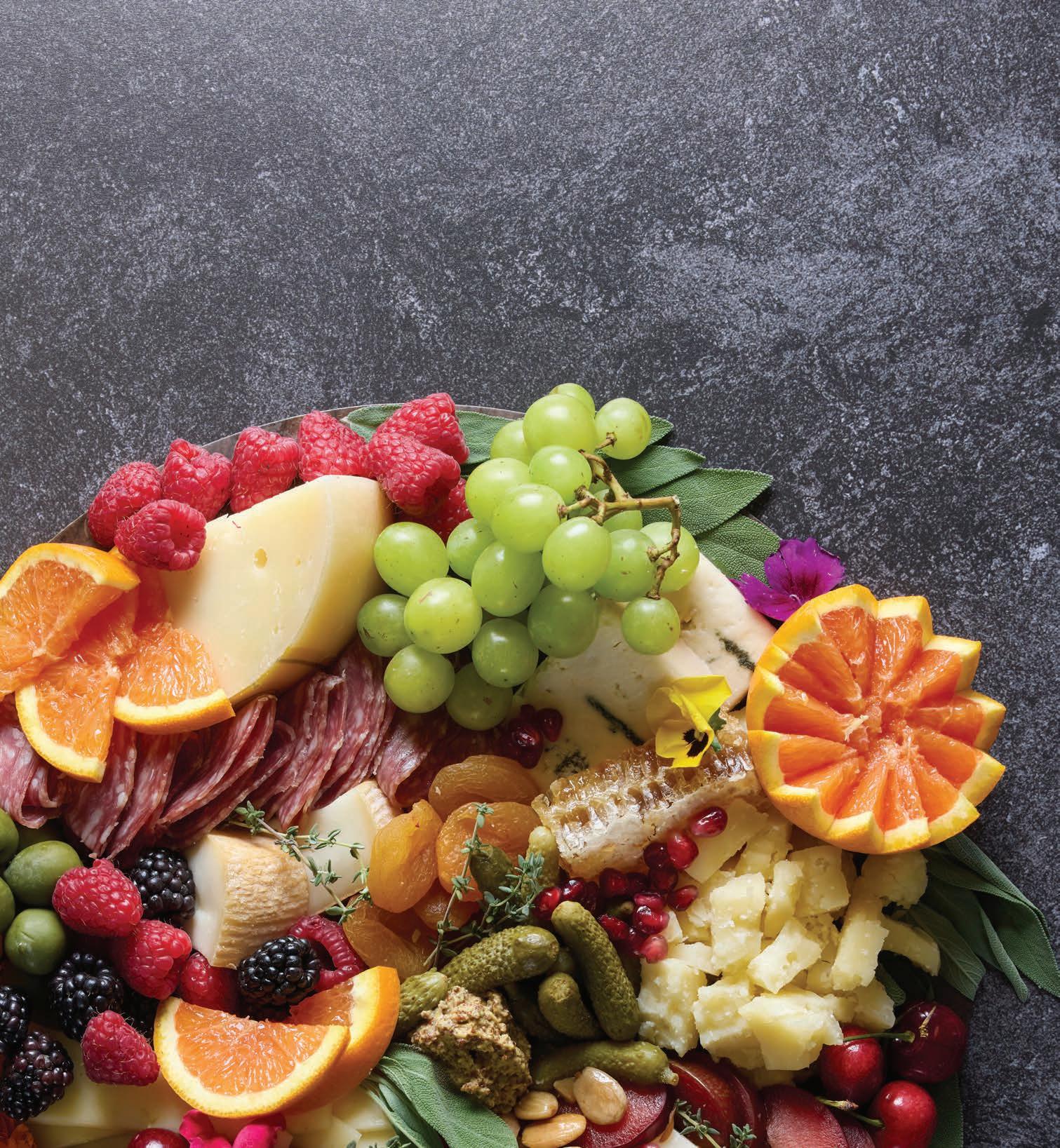
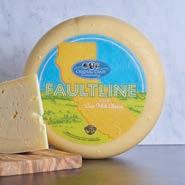



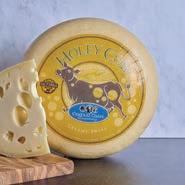
BY LINDSEY MENDES PHOTOGRAPHY BY LEE IBARRA
Balancing intensity and approachability, the dense, semi-crumbly blue cheese made from 100% goat’s milk has pronounced piquant character. Finishes with clean, grassy notes and a smooth mouthfeel.
Pairs Well With honeycomb, French baguette, peaches, floral white wines
This crowd pleaser of crumbly cow’s milk cheese is aged for six months to achieve a slightly nutty flavor, with a tyrosine crystal crunch. Winner of ‘Best of California’ at the 2023 California State Cheese Competition.
Pairs Well With apples, dark chocolate, blackberry compote
A medium-aged cheddar of equal balance of creamy to sharp. Hatch Valley chile-infused, offering mild heat and vegetal complexity with a smooth melt, firm texture. A layered flavor profile ideal for culinary applications from melting to slicing and shredding.
Pairs Well With smoked meats, mezcal, margaritas with extra salt, roasted chicken
Blend of tangy goat’s milk and rich cow’s milk, appealing even to goat cheese skeptics. Opens with subtle notes of pear and fresh apple and evolves into a smooth, creamy finish with hints of sweet cream and a touch of salinity.
Pairs Well With chocolate-covered strawberries, prosciutto, GSM wine
Washed-rind goat cheese aged for two to three weeks. Once unwrapped, the funky orange rind and a moderate piquant aroma meet you with notes of olive oil and tropical fruits. Pungent and toothsome.
Pairs Well With fruity macarons, fall fruits, sparkling wine, or try melting into fondue
A classic young Swiss-style cheese dotted with playful holes, packed with flavors of browned butter and roasted peanuts.
Pairs Well With black pepper, grapes, cured meats, or melt over roasted potatoes


BY REID PHILLIPS, HEAD CHEF AT CALCAREOUS VINEYARD PHOTOGRAPHY BY MARY LAGIER
SERVES 4–6
2 tablespoons extra virgin olive oil
1 medium onion, diced
2 carrots, diced
2 celery stalks, diced
3 garlic cloves, minced
1 teaspoon salt, or to taste
½ teaspoon black pepper
½ teaspoon paprika
4 cups chicken or vegetable broth
2 (15-ounce) cans cannellini or white beans
1 medium potato, peeled and diced
2 cups green cabbage, chopped (about ¼ head)
1 teaspoon thyme
1 bay leaf
½ cup fresh dill, chopped
Juice of ½ lemon
Sour cream or Greek yogurt, for garnish




Step 1
In large pot, heat olive oil over medium heat. Add onions and cook until sweating, about 5 minutes. Add carrots and celery; cook until soft, about 5 minutes. Add garlic until fragrant, about 30 seconds. Season with salt, pepper and paprika. Add broth, beans, potatoes, cabbage, thyme and bay leaf. Bring to a boil, then reduce to a simmer.
Step 2
Cover and simmer for 20–25 minutes, until all vegetables are fork tender. Stir in dill and lemon juice, adjusting seasoning to taste.
Step 3
Serve in a warm bowls with dollop of sour cream or Greek yogurt.

For over a century we’ve served customers who can do just about anything. You deserve a financial partner who works as hard as you do.
